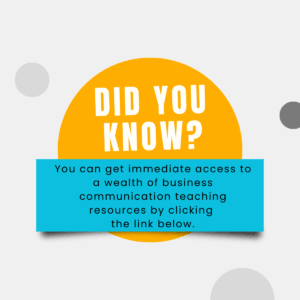
Get immediate access to these resources.
Read more
Take advantage of these complimentary resources you can use
in keeping your class relevant and up to date. Read More
 It’s a phrase uttered in boardrooms, sales calls, and casual conversations alike—“I’ll think about it.” On the surface, it suggests consideration, an open-ended decision still in progress. But beneath its polite exterior, an unspoken reality lurks: in most cases, it really means “probably not.”
It’s a phrase uttered in boardrooms, sales calls, and casual conversations alike—“I’ll think about it.” On the surface, it suggests consideration, an open-ended decision still in progress. But beneath its polite exterior, an unspoken reality lurks: in most cases, it really means “probably not.”
How did these five words become the linguistic equivalent of a ghostly handshake—an agreement that exists in name only? What unseen psychological forces transformed this once-neutral phrase into a coded rejection?
The answer lies in our innate discomfort with direct refusal. Humans are social creatures, wired to avoid conflict and preserve relationships. Saying “no” outright can feel too final, too confrontational. Instead, people lean on ambiguity, choosing socially acceptable deferrals that soften the blow while leaving the door slightly ajar.
But here’s where the mystery deepens: why do we all seem to instinctively understand this hidden meaning? Over time, cultural norms and repeated experiences have trained us to recognize “I’ll think about it” as a diplomatic dodge—a signal that no further action is likely. It’s a shared secret, an unspoken agreement where both sides know the truth but play along anyway.
And yet, the phantom agreement carries real consequences. In business, it breeds false hope, wasted follow-ups, and prolonged indecision. Deals stall, negotiations drag on, and opportunities vanish into the ether, all because a definitive answer was never given.
So how do we solve this puzzle? By bringing the hidden message to light. Recognizing “I’ll think about it” for what it truly is allows us to cut through ambiguity and encourage more honest conversations. Whether by gently prompting for clarity (“What concerns do you have?”) or offering an easy exit (“Would it be fair to say this isn’t the right fit?”), we can transform vague hesitations into decisive outcomes.
The mystery of the phantom agreement isn’t just about language—it’s about the silent forces shaping our interactions. And once you learn to decode them, you’ll never hear “I’ll think about it” the same way again.
So, the question remains: Will you accept the illusion, or will you uncover the truth?
Read moreThe rise of digital, social, and visual media has fundamentally transformed how businesses communicate with their audiences and build meaningful connections. To prepare students for success in this fast-paced and ever-evolving landscape, it’s essential that business communication textbooks address the critical skills needed to navigate these mediums effectively. From crafting impactful digital messages to leveraging social platforms and creating compelling visuals, today’s professionals require a robust foundation.
This quiz helps you evaluate whether your current textbook covers the essential AI-driven tools and strategies students need to succeed. Answer the following 20 “yes” or “no” questions to see how your textbook measures up in preparing students for the future of business communication.
1. Does your textbook explain how AI tools optimize email subject lines for engagement and clarity?
2. Does your textbook show how AI automates email drafting and improves tone and readability?
3. Does your textbook include how AI-driven messaging systems enhance collaboration and productivity?
4. Does your textbook highlight how AI analytics help track and improve digital media performance?
5. Does your textbook discuss how AI generates audience-specific digital content efficiently?
6. Does your textbook explain how AI tools assist in creating, scheduling, and managing social media posts?
7. Does your textbook demonstrate how AI analyzes social media engagement metrics to refine strategies?
8. Does your textbook include guidance on using AI for sentiment analysis in social media monitoring?
9. Does your textbook show how AI supports A/B testing to evaluate and improve social media content?
10. Does your textbook explore how AI tools enhance influencer outreach and campaign management?
11. Does your textbook explain how AI generates visual content, such as infographics, tailored to audience needs?
12. Does your textbook demonstrate how AI streamlines the creation of visually appealing slides and presentations?
13. Does your textbook include examples of AI tools that assist with data visualization for reports and presentations?
14. Does your textbook teach how AI can create culturally sensitive and inclusive visual content?
15. Does your textbook explore the role of AI in simplifying video production for digital media?
16. Does your textbook explain how AI tools improve accessibility with features like captions and alt text for visuals?
17. Does your textbook discuss how AI identifies trends and patterns in social media data?
18. Does your textbook highlight ethical considerations of using AI in social media and digital marketing?
19. Does your textbook show how AI personalizes social media responses for customer engagement?
20. Does your textbook provide case studies or examples of AI’s role in creating impactful digital, social, and visual media?
If you answered “no” to any of these questions, it’s time to face reality: your textbook is out of date and failing to keep pace with today’s business communication demands.
In today’s fast-paced, technology-driven landscape, students require a textbook that not only keeps pace with innovation but empowers them to leverage AI as a transformative tool. Imagine the impact of an approach that seamlessly integrates cutting-edge AI concepts into your course, equipping your students with the practical skills and forward-thinking mindset needed to excel in the real world. Elevate your curriculum and set your students apart by preparing them to thrive in an AI-powered future.
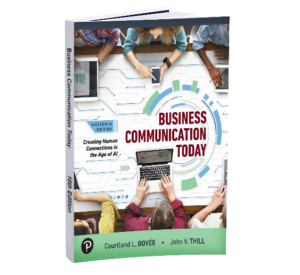 Business communication instructors and their students can step into the future of business communication with the new, groundbreaking 16th edition of Business Communication Today— where artificial intelligence meets time-tested principles. For the first time, artificial intelligence (AI) is seamlessly integrated into every chapter, making this the first business communication text on the market to offer comprehensive AI coverage. Order an examination copy today.
Business communication instructors and their students can step into the future of business communication with the new, groundbreaking 16th edition of Business Communication Today— where artificial intelligence meets time-tested principles. For the first time, artificial intelligence (AI) is seamlessly integrated into every chapter, making this the first business communication text on the market to offer comprehensive AI coverage. Order an examination copy today.
 From a student's frustration with complex design software emerged one of technology's most transformative success stories. Melanie Perkins, while teaching graphic design at university in Perth, Australia, observed her students spending entire semesters just learning where buttons were located in professional design programs. This pain point sparked a revolutionary idea: what if design could be accessible to everyone?
From a student's frustration with complex design software emerged one of technology's most transformative success stories. Melanie Perkins, while teaching graphic design at university in Perth, Australia, observed her students spending entire semesters just learning where buttons were located in professional design programs. This pain point sparked a revolutionary idea: what if design could be accessible to everyone?
Along with co-founders Cliff Obrecht and Cameron Adams, Perkins turned this vision into Canva, a platform that has democratized design for the digital age. What began as a modest solution for yearbook creation has exploded into a global phenomenon, with nearly 200 million users across 190 countries creating 15 billion designs in over 100 languages.
Canva's timing couldn't be better, positioning itself at the confluence of two powerful trends reshaping business communication: the dominance of visual content and the rise of artificial intelligence. The platform has become indispensable for professionals across industries, from marketing to human resources, who need to create polished visual materials without traditional design training.
While professional graphic designers remain essential for complex creative work, Canva has pioneered what it calls the "visual economy" – a world where basic design capabilities are becoming as fundamental as email skills in the workplace. Through AI-enabled tools and intuitive interfaces, Canva has transformed design from an exclusive professional skill into an accessible language that anyone can speak, fundamentally changing how we communicate in the digital age.
NOTE: This story about Canva is a summarization of the chapter-opening vignette, Communication Close-Up, that appears exclusively in Chapter 9 of Business Communication Today, 16th Edition, by Bovee and Thill (Pearson). At the end of the chapter is a Communication Challenge that gives students an opportunity to apply their knowledge and skills to a real-world scenario at Canva, enhancing critical thinking and practical application skills while reinforcing the key concepts covered in the chapter.
Business communication instructors and their students can step into the future of business communication with the new, groundbreaking 16th edition of Business Communication Today by Courtland Bovee and John Thill—where artificial intelligence meets time-tested principles. For the first time, artificial intelligence (AI) is seamlessly integrated into every chapter, making this the first business communication textbook on the market to offer comprehensive AI coverage.
Neuroscience Meets Business Communication Education
This text integrates research-based principles from neuroscience to enhance learning. This innovative approach aligns with how the brain learns, retains, and applies information, transforming how business communication is taught and mastered. Imagine students who don’t just memorize concepts but confidently apply them. With engagement soaring and retention deepening, your classroom is where communication skills are mastered for life. Give your students the neuroscience advantage. Join leading colleges and universities already seeing remarkable results with our neuroscience-based approach.
Read more
A mischievous cat makes a daring escape from a fishmonger’s shop, clutching its prize—a fresh fish gleaming in its jaws. This playful scene captures the potential of AI-generated imagery, blending creativity and realism seamlessly to tell unexpected visual stories.
AI-powered image generation continues to advance, offering cutting-edge tools that transform creative processes across industries. Business communication specialists can now leverage these platforms for various tasks, including content creation and business communication instruction. Some offer their services for free. Below are key developments and innovative tools shaping the current landscape.
Key AI Image Generators
1. DALL-E 3: This version boasts enhanced photorealism and superior text interpretation, integrated into Microsoft’s Designer and Bing Image Creator. It’s ideal for crafting precise visuals that enhance business communication instruction, from presentation graphics to product illustrations.
2. Ideogram: This tool excels in generating both visuals and text-rich images. With its Magic Prompt feature, users can optimize input prompts, making it highly effective for educational settings, such as developing infographics and instructional materials.
3. Craiyon: Known for accessibility, Craiyon offers a free platform that allows quick visual prototyping. It can be a valuable resource for educators looking to create visual aids for classroom activities or business communication instruction sessions.
4. Canva AI: Canva’s AI features facilitate the creation of branded communications. Its templates and image-generation tools streamline content development, making it a go-to for instructors managing social media pages or newsletters.
5. Runway AI: Specializing in video creation, Runway AI empowers business communication professionals to produce polished instructional videos and video presentations, essential for e-learning and digital communication strategies【9†source】.
6. Imagine Art: Focused on creative output, Imagine Art enables users to produce diverse imagery for unique marketing campaigns and instructional presentations, supporting both corporate and educational environments【9†source】.
How AI Image Generators Can Be Used in Business Communication
• Visual Storytelling for Instruction: AI-generated images enhance the delivery of complex topics in business communication instruction by providing visual support that aids comprehension.
• Customized Marketing Campaigns: With tools like Canva AI and DALL-E 3, professionals can develop personalized visuals aligned with brand narratives or seasonal themes.
• Content Development and Social Media: These platforms streamline the creation of blog graphics, infographics, and social media visuals, ensuring a cohesive content strategy.
• Training and Educational Materials: Runway AI and Canva AI are instrumental in producing e-learning modules, instructional videos, and interactive presentations for business communication instruction.
• Rapid Prototyping and Brainstorming Sessions: Ideogram and Craiyon support idea visualization, making them useful in workshops, meetings, and educational settings for concept illustration and mockups.
AI image generation tools offer immense potential for enhancing business communication instruction and engaging with diverse audiences. As the technology evolves, these platforms empower professionals to blend creativity with efficiency, ensuring impactful communication across all channels. By integrating these tools into their work, instructors and communication specialists can create visually compelling and effective educational materials tailored to their audience’s needs.
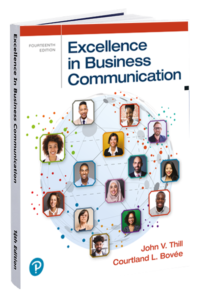
How Excellence in Business Communication Prepares Students for the Age of AI Image Generation
Excellence in Business Communication is an ideal textbook for integrating AI image generation into business communication courses due to its focus on practical skills, emerging trends, and real-world application. This text emphasizes how digital tools enhance communication, aligning perfectly with the use of AI-generated visuals in professional and educational settings. As businesses increasingly adopt AI technologies for content creation, this book ensures students are well-prepared to navigate these innovations.
AI image generators, like DALL-E 3, Canva AI, and Runway AI, offer new ways to create engaging presentations, marketing content, and instructional materials. Excellence in Business Communication encourages students to explore multimodal communication strategies, including visual and digital literacy, fostering the skills necessary to integrate these tools effectively.
The textbook's focus on ethics and responsible communication aligns with discussions on copyright and AI usage, critical issues as students learn to generate and use AI-based content. Through activities that simulate real-world scenarios, the book encourages students to apply AI tools creatively while maintaining professionalism.
By using this text alongside AI generators, students develop both technical proficiency and communication strategies essential in today’s AI-driven environment, ensuring they stay competitive and adaptive in evolving business environments.
Read more

Tailored teaching methods empower quiet students through confidence-building exercises.
1. Implementing Emotional Intelligence for Effective Teaching
In today's dynamic business environment, effective communication is no longer merely about conveying information; it's about building relationships, navigating complex interactions, and fostering understanding. Emotional intelligence (EI) has emerged as a critical factor in achieving these goals, particularly in the field of business communication education. This article explores the multifaceted role of EI in teaching business communication, providing insights into its significance, practical applications, and strategies for development. By understanding and implementing EI principles, instructors can cultivate more engaging, supportive, and successful learning environments, preparing students for thriving careers in the business world.
2. Understanding Emotional Intelligence in Education
Emotional intelligence, as defined by Salovey and Mayer (1990), is the ability to perceive, understand, manage, and utilize emotions effectively. It involves being aware of our own emotions, understanding those of others, and using this emotional knowledge to guide our thinking and actions. In the context of teaching business communication, EI enables instructors to navigate their own emotions, effectively understand students' needs, and foster a positive learning atmosphere conducive to effective communication and skill development.
2.1 Key Components of Emotional Intelligence
Drawing from Goleman's (1995) model, five key components of EI are particularly relevant to teaching business communication:
Self-Awareness: Recognizing one's own emotional state, understanding the impact of emotions on behavior, and identifying triggers that influence emotional responses.
Empathy: Understanding others' feelings and perspectives, actively listening to their concerns, and responding with sensitivity and care.
Self-Regulation: Managing one's emotions and behaviors effectively, remaining calm under pressure, and responding constructively to challenging situations.
Social Skills: Building and maintaining healthy relationships, communicating effectively, resolving conflicts constructively, and collaborating effectively in teams.
Motivation: Having a strong internal drive to achieve goals, maintaining enthusiasm and passion for teaching, and inspiring students to strive for excellence.
2.2 The Relevance of EI in Business Communication Education
Research by Jennings and Greenberg (2009) highlights that teachers with higher EI create more supportive classroom environments, leading to improved student outcomes. In business communication courses, where interpersonal skills and effective communication are paramount, the instructor's EI can significantly influence students' learning experiences and future professional success. Students learn not only by absorbing information but also by observing and emulating the communication styles of their instructors.
3. Specific Emotional Skills for Teaching Business Communication
3.1 Self-Awareness
Example: An instructor who is self-aware can recognize their own frustration when students are disengaged and, instead of reacting impulsively, can address the root cause calmly. This might involve reflecting on the lesson plan and adjusting teaching methods to better engage students.
Research Insight: A study by Brackett et al. (2010) found that teachers with higher emotional self-awareness reported less burnout and greater job satisfaction. This highlights how self-awareness can not only benefit students but also contribute to the instructor's own well-being.
3.2 Empathy
Example: A business communication instructor demonstrating empathy when a student struggles with public speaking can offer tailored support, encouraging the student to overcome anxiety through gradual exposure and positive reinforcement. This might involve providing the student with additional practice opportunities, offering feedback in a supportive manner, and helping them develop personalized strategies for managing their anxiety.
Research Insight: Cornelius-White (2007) meta-analysis showed that teacher empathy was associated with increased student participation and motivation. Empathy creates a safe space for students to learn and grow, fostering a more inclusive and productive classroom environment.
3.3 Self-Regulation
Example: During a heated class debate on a controversial business ethics case, an emotionally intelligent instructor remains calm, moderating the discussion without bias. They ensure that diverse viewpoints are respected and explored constructively, facilitating a respectful and productive dialogue.
Research Insight: Sutton and Wheatley (2003) review suggests that teachers' ability to regulate their emotions is crucial for creating a positive classroom climate. By managing their own emotions effectively, instructors can create a more harmonious environment where students feel safe to express their ideas and engage in productive discussions.
3.4 Social Skills
Example: Facilitating group work effectively in a business communication course requires strong social skills to resolve conflicts, engage quiet students, and maintain productivity. An instructor might use techniques like role rotation, structured feedback sessions, and conflict-resolution strategies to ensure all voices are heard and contributions are valued.
Research Insight: Zins et al. (2004) compilation of studies demonstrates that social and emotional learning programs improve students' social-emotional skills and academic performance. Investing in social skills development for both instructors and students creates a more collaborative and supportive learning environment.
3.5 Motivation
Example: A motivated business communication instructor engages students by integrating real-world case studies, current events, and relevant industry trends to keep the content exciting and relevant. They might invite guest speakers from industry, organize field trips to local businesses, or encourage students to participate in real-world projects.
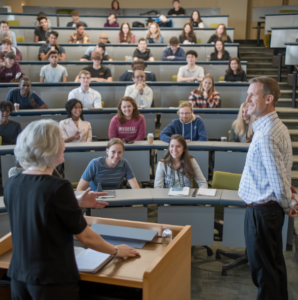 Enterprising instructors elevate business communication courses with real-world insights from visiting experts.[/caption]
Enterprising instructors elevate business communication courses with real-world insights from visiting experts.[/caption]
Research Insight: Kunter et al. (2008) found that teacher enthusiasm was positively related to students' interest and enjoyment in the subject matter. By demonstrating genuine passion and engagement, instructors can inspire and motivate students to develop a deeper understanding and appreciation for business communication.
4. How Emotional Intelligence Improves Teaching Business Communication
4.1 Enhancing Classroom Management
EI helps instructors create a more positive and productive learning environment by:
Recognizing and Addressing Individual Student Needs: By being attuned to student emotions, instructors can identify those struggling and provide tailored support, creating a more equitable and inclusive learning experience.
Diffusing Potential Conflicts Before They Escalate: By developing strong social skills and a sense of empathy, instructors can effectively resolve conflicts constructively, preventing escalation and fostering a more collaborative classroom environment.
Creating a Culture of Respect and Open Communication: When instructors model respectful communication, students are more likely to follow suit. This creates a positive and safe environment for open dialogue, idea sharing, and constructive feedback.
Example: An instructor who perceives a drop in student engagement might introduce interactive exercises or discussions, break down complex concepts into smaller chunks, or utilize technology-enhanced learning tools to re-engage the class rather than continuing with the same lecture format.
4.2 Effective Feedback Delivery
Emotionally intelligent feedback is:
Constructive and Growth-Oriented: Feedback focuses on specific behaviors or skills, offering constructive suggestions for improvement rather than dwelling on shortcomings.
Tailored to Individual Student Needs: Feedback is personalized to address each student's unique strengths, weaknesses, and learning style.
Delivered with Empathy and Respect: Feedback is delivered in a compassionate and respectful manner, recognizing the student's efforts and fostering a supportive learning environment.
Example: Instead of saying, "Your presentation lacked structure," a high-EI instructor might say, "You've got strong points—let's work on organizing them more clearly for maximum impact. What do you think about using a problem-solution format?" This approach is more constructive and encourages the student to actively participate in the improvement process.
4.3 Building Student-Instructor Relationships
Strong emotional connections with students foster a positive learning environment where students feel supported and are more likely to take academic risks.
Example: Instructors who check in with students individually, understand their goals, and encourage open communication build stronger, more trustful relationships. This might involve regular office hours, one-on-one progress meetings, or even informal chats before or after class to build rapport and show genuine interest in their students' well-being and academic progress.
4.4 Navigating Difficult Conversations
EI equips instructors to handle sensitive issues with tact and effectiveness.
Example: When discussing a student's underperformance, an emotionally intelligent instructor might first ask questions to understand if external factors are affecting the student before proposing solutions. They might say, "I've noticed a change in your participation lately. Is everything okay? I'm here to support you if you're facing any challenges." This approach demonstrates empathy and a willingness to help the student overcome any obstacles they may be facing.
5. Developing Emotional Intelligence in Instructors
5.1 Self-Reflection
Keep a Teaching Journal: Regularly record emotional responses, challenging situations, and successful strategies. This practice can enhance self-awareness and identify areas for growth.
Regularly Assess Personal Strengths and Areas for Improvement: Utilize self-assessment tools or seek feedback from peers and mentors to gain a deeper understanding of your own EI strengths and areas for development.
Seek Feedback from Peers and Students: Constructive feedback from colleagues and students can provide valuable insights into your communication style and emotional impact on the learning environment.
5.2 Professional Development
Attend Workshops Focused on EI in Education: Workshops can provide practical strategies and tools to develop EI skills specific to the teaching profession.
Participate in Role-Playing Exercises to Practice EI Skills: Role-playing scenarios can help you develop emotional awareness and practice communication skills in challenging situations.
Engage in Ongoing Learning About EI Through Books, Courses, and Seminars: Continuously expanding your knowledge of EI will enhance your ability to apply these principles in the classroom.
5.3 Peer Collaboration
Establish a Mentoring Program with Experienced, Emotionally Intelligent Instructors: Mentorship can provide valuable guidance and support in developing your EI skills and navigating challenging situations.
Create Opportunities for Peer Observation and Feedback: Observe colleagues who demonstrate strong EI skills and solicit constructive feedback on your own teaching practices.
Form a Professional Learning Community Focused on EI in Teaching: Collaborate with other educators to share ideas, strategies, and resources related to EI in the classroom.
5.4 Mindfulness Practices
Incorporate Meditation or Deep Breathing Exercises into Daily Routine: Mindfulness practices can enhance self-awareness, emotional regulation, and stress management.
Practice Mindfulness During Teaching to Stay Present and Aware: Bring your attention to the moment, responding to students with presence and understanding rather than allowing distractions to cloud your judgment.
Use Mindfulness Apps or Guided Sessions to Develop Consistent Practice: Utilize technology-aided mindfulness tools to support your ongoing practice and integrate mindfulness into your daily life.
6. Benefits of Fostering Emotional Intelligence in Teaching Business Communication
6.1 Improved Student Engagement

Tailored teaching methods empower quiet students through confidence-building exercises.
Example: An instructor who understands individual student challenges can adapt their teaching methods, encouraging quieter students to participate through low-stakes, confidence-building exercises like think-pair-share activities or online discussion boards.
Research Insight: Reyes et al. (2012) found that classrooms with higher emotional climate scores showed higher levels of student engagement. EI contributes to a more positive and supportive learning environment, where students feel valued and are more likely to engage actively in the learning process.
6.2 Higher Student Retention
Example: A business communication instructor who shows concern for student well-being and academic growth helps students feel more connected to the course and the instructor. This might involve regular check-ins, personalized feedback, and creating a supportive class community.
Research Insight: O'Keeffe (2013) review suggests that a sense of belonging and positive student-faculty interactions contribute significantly to student retention. Building strong relationships with students fosters a sense of belonging and support, reducing the likelihood of them dropping out of the course.
6.3 Better Conflict Resolution
Example: When a conflict arises in group work, an emotionally intelligent instructor facilitates a discussion that encourages understanding and cooperation, rather than letting tensions fester. They might use techniques like active listening, perspective-taking exercises, and conflict resolution strategies to help students reach a resolution.
Research Insight: Schonert-Reichl (2017) overview indicates that teachers with higher EI are better equipped to handle classroom conflicts and teach conflict resolution skills to students. EI equips instructors to model effective conflict resolution, empowering students to develop these essential communication skills.
6.4 Enhanced Professional Development
Example: An emotionally intelligent instructor who demonstrates empathy and leadership in the classroom is more likely to be chosen for leadership roles in academic or administrative capacities. They might be asked to lead workshops, mentor new faculty, or contribute to curriculum development.
Research Insight: Wong et al. (2010) study found that EI was positively related to job performance and career advancement in various professions, including education. By developing their EI, instructors not only enhance their teaching effectiveness but also improve their overall professional growth and career prospects.
7. Challenges and Solutions in Implementing EI in Business Communication Courses
7.1 Time Constraints
Challenge: Instructors may feel pressure to cover content, leaving little time for EI development.
Solution: Integrate EI skills into existing lessons. For example, use group projects to teach both business writing and emotional intelligence simultaneously. Incorporate short, focused activities throughout the course to foster self-awareness, empathy, and communication skills.
7.2 Resistance to Change
Challenge: Some instructors or institutions may be skeptical about the importance of EI.
Solution: Share research on the benefits of EI in education and business. Pilot EI-focused teaching methods in one course and compare outcomes with traditional approaches. Demonstrate the positive impact of EI on student engagement, performance, and retention, highlighting the tangible benefits of implementing these principles.
7.3 Lack of Training
Challenge: Many instructors may not have formal training in EI.
Solution: Develop in-house training programs or partner with EI experts to provide workshops. Encourage peer-to-peer learning and mentoring. Facilitate opportunities for instructors to learn from each other and share best practices for incorporating EI into their teaching.
8. The Student Perspective: Developing EI Through Business Communication Courses
While this article focuses on instructors, it's crucial to recognize that business communication courses offer an excellent opportunity for students to develop their own EI skills.
8.1 Incorporating EI into Curriculum
Include lessons on active listening and empathy in communication modules: Emphasize the importance of understanding and responding to emotional cues in verbal and nonverbal communication.
Teach conflict resolution strategies as part of team communication skills: Equip students with the tools and techniques to navigate conflicts effectively and productively.
Incorporate self-reflection exercises after presentations or group projects: Encourage students to analyze their own emotional responses and communication effectiveness, identifying areas for improvement.
8.2 Translating EI Skills to the Workplace
Example: Students can learn to apply EI skills in professional scenarios through role-playing exercises, case studies, and internships. For instance, practicing how to give constructive feedback, navigate a difficult conversation with a colleague, or lead a team meeting effectively.
Research Insight: Lopes et al. (2006) study found that individuals with higher EI reported better workplace relationships and higher job performance. By equipping students with EI skills, we empower them to build stronger professional relationships, navigate complex workplace dynamics, and achieve greater success in their careers.
9. Adapting EI to Current Trends in Business Communication
9.1 Remote Work and Digital Communication
Teach students to recognize emotional cues in written communication and video calls: Help students develop strategies for decoding emotional signals in digital communication, considering tone of voice, emoji usage, and written language.
Develop strategies for building rapport and trust in virtual teams: Explore methods for establishing strong connections and fostering a sense of community within virtual teams.
9.2 Cross-Cultural Communication
Incorporate cultural intelligence (CQ) alongside EI to prepare students for global business interactions: Teach students to navigate cultural differences, understand diverse perspectives, and communicate effectively across cultures.

Unlocking your students’ global potential: Develop students' cultural intelligence (CQ) alongside emotional intelligence (EI) to empower them in diverse business environments.
Use diverse case studies and examples to broaden students' perspectives: Expose students to a range of cultural contexts and communication styles, preparing them for a globalized business environment.
9.3 AI and Emotional Intelligence
Discuss the role of EI in human-AI collaboration: Explore how EI enables humans to bring unique strengths and skills to the workplace, such as empathy, creativity, and critical thinking.
Explore how EI gives humans a unique advantage in an increasingly automated workplace: Highlight the importance of EI in developing strong interpersonal skills, navigating complex social interactions, and fostering meaningful relationships, which are skills that machines cannot easily replicate.
Key Takeaways
Emotional intelligence is a crucial component of effective teaching in business communication. By developing and applying EI skills, instructors can create more engaging, supportive, and successful learning environments. This not only enhances the teaching experience but also equips students with vital skills for their future careers in business.
As we navigate the evolving landscape of business communication education, the importance of EI will only grow. Instructors who prioritize their own EI development and integrate these skills into their teaching will be better prepared to meet the challenges of modern education and prepare their students for success in the business world.

Why Excellence in Business Communication Is the Perfect Textbook for Emotionally Intelligent Instructors
Excellence in Business Communication is the ideal text for instructors who value emotional intelligence (EI) in teaching, as it aligns with key EI principles such as self-awareness, empathy, self-regulation, and motivation. The text fosters a learning environment where emotional awareness, interpersonal dynamics, and constructive communication thrive, mirroring the realities of today's business world. It provides a comprehensive approach to communication that goes beyond technical skills, addressing the human aspects of interaction that are critical in modern business.
For instructors who prioritize EI, this textbook offers a wealth of real-world scenarios and case studies. These activities engage students in reflective and interactive learning, encouraging them to apply EI skills like active listening, empathy, conflict resolution, and social skills. The text goes beyond technical communication by helping students understand and navigate the emotional and psychological dynamics that shape professional interactions, making it an essential resource for fostering emotional intelligence alongside communication proficiency.
The textbook's structure also supports emotionally intelligent teaching through interactive discussions, group activities, and reflective exercises. These tools help instructors foster a positive, inclusive classroom environment, reinforcing student engagement, trust, and skill-building through growth-oriented, empathetic feedback. This encourages students to actively participate, develop interpersonal skills, and build confidence in their communication abilities.
Excellence in Business Communication is more than just a textbook for teaching communication skills—it’s a resource that supports the development of emotional intelligence in both instructors and students. By offering emotionally intelligent learning experiences, it equips students with the tools needed to foster meaningful relationships, navigate complex social interactions, and develop the emotional resilience critical for success in the modern business environment.
References
Brackett, M. A., Palomera, R., Mojsa-Kaja, J., Reyes, M. R., & Salovey, P. (2010). "Emotion-regulation ability, burnout, and job satisfaction among British secondary-school teachers." Psychology in the Schools, 47(4), 406-417.
Cornelius-White, J. (2007). "Learner-centered teacher-student relationships are effective: A meta-analysis." Review of Educational Research, 77(1), 113-143.
Goleman, D. (1995). "Emotional Intelligence." Bantam Books.
Jennings, P. A., & Greenberg, M. T. (2009). "The prosocial classroom: Teacher social and emotional competence in relation to student and classroom outcomes." Review of Educational Research, 79(1), 491-525.
Kunter, M., Tsai, Y. M., Klusmann, U., Brunner, M., Krauss, S., & Baumert, J. (2008). "Students' and mathematics teachers' perceptions of teacher enthusiasm and instruction." Learning and Instruction, 18(5), 468-482.
Lopes, P. N., Grewal, D., Kadis, J., Gall, M., & Salovey, P. (2006). "Evidence that emotional intelligence is related to job performance and affect and attitudes at work." Psicothema, 18, 132-138.
O'Keeffe, P. (2013). "A sense of belonging: Improving student retention." College Student Journal, 47(4), 605-613.
Reyes, M. R., Brackett, M. A., Rivers, S. E., White, M., & Salovey, P. (2012). "Classroom emotional climate, student engagement, and academic achievement." Journal of Educational Psychology, 104(3), 700-712.
Salovey, P., & Mayer, J. D. (1990). "Emotional intelligence. Imagination, Cognition and Personality," 9(3), 185-211.
Schonert-Reichl, K. A. (2017). "Social and emotional learning and teachers."The Future of Children, 27(1), 137-155.
Sutton, R. E., & Wheatley, K. F. (2003). "Teachers' emotions and teaching: A review of the literature and directions for future research." Educational Psychology Review, 15(4), 327-358.
Wong, C. S., Wong, P. M., & Peng, K. Z. (2010). "Effect of middle-level leader and teacher emotional intelligence on school teachers' job satisfaction: The case of Hong Kong." Educational Management Administration & Leadership, 38(1), 59-70.
Zins, J. E., Weissberg, R. P., Wang, M. C., & Walberg, H. J. (Eds.). (2004). Building academic success on social and emotional learning: What does the research say? Teachers College Press.
Friction from outdated methods hinders business communication education, but a frictionless classroom empowers student success.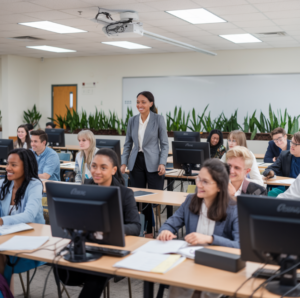
In today's fast-paced business world, communication is not just a skill; it's a superpower. The ability to articulate ideas clearly, persuade effectively, and collaborate seamlessly is a key differentiator for success. Yet, in many classrooms, the teaching of business communication can feel more like a struggle than a launchpad. Outdated methods, a disconnect between theory and practice, and a lack of clarity can create a frustrating "friction" that hinders both student engagement and effective learning.
Imagine a classroom where learning business communication is not just a chore, but a thrilling adventure. Imagine students energized by the relevance of their studies, empowered by practical application, and equipped with the digital tools they'll use daily. This is the vision of a "frictionless classroom" – a space where the barriers to mastering business communication are dismantled, and students emerge ready to thrive in the real world. This is not simply about improving educational efficiency; it's about unlocking the true potential of business communication education and empowering a new generation of confident, skilled communicators who are ready to lead.
The Roadblocks to Effective Business Communication
The challenges hindering the effective teaching of business communication are multifaceted and often deeply rooted in the way we approach education itself. Take a moment to picture a student struggling to see the relevance of a dusty textbook in an age of instant messaging and dynamic social media. Imagine a student bewildered by a lack of clarity around expectations or confused by an instructor's reliance on outdated tools. These are not isolated incidents; they are symptoms of a broader disconnect between traditional teaching methods and the realities of the modern business world.
The roadblocks to effective communication education are many, but they can be categorized as follows:
Outdated Course Materials: Many curricula cling to traditional communication formats like formal letters and memos, failing to reflect the reality of today's digital workplaces. This disconnect makes learning feel irrelevant and hinders engagement. Students may find themselves bored and unmotivated, unable to see how the skills they are learning will apply to their future careers. They might ask, "Why am I spending time learning how to write a formal memo when I'll be communicating primarily through email and social media in my professional life?" This disconnect between the curriculum and the real world erodes motivation and hinders true learning.
Misaligned Expectations and Communication: Fuzzy objectives, unclear instructions, and a lack of open communication between students and instructors create uncertainty and frustration. Students might feel lost, unsure of what is expected of them, or hesitant to ask for clarification, leading to misunderstandings and a lack of confidence in their abilities. This can also lead to a lack of trust between students and instructors, as students feel they are not being given the support they need to succeed.
Technological Gaps: The rapid pace of technological change often leaves students and instructors struggling to keep up. Students may be unfamiliar with the tools they will use in their careers, while instructors might not fully leverage the power of these tools in the classroom. The result can be a frustrating disconnect between the theoretical knowledge gained in class and the practical skills required in the modern workplace. Imagine a student struggling to create a professional presentation using video conferencing tools, only to discover they have never been taught how to use these essential technologies effectively.
Information Overload: A bombardment of theoretical concepts without sufficient time for practical application can leave students feeling overwhelmed and disengaged. This can lead to students struggling to retain information, feeling overwhelmed, and lacking the confidence to apply the concepts in real-world scenarios. Imagine a student trying to process complex communication models without the opportunity to practice these concepts in real-world scenarios.
The Theory-Practice Disconnect: Students often struggle to see how abstract communication models translate into real-world scenarios. Without practical experience, theoretical concepts can remain distant and ineffective. Students might find themselves unable to connect the dots between the textbook and their everyday lives, leading to a feeling of disconnect and a lack of motivation to truly master the material. Imagine a student learning about persuasion techniques without ever having the chance to craft a persuasive email or present a compelling argument to a group.
Building a Frictionless Classroom: A Path Forward
Eliminating friction in business communication education requires a fundamental shift in mindset and approach. Instead of clinging to outdated practices, educators must embrace the dynamic nature of the modern business world and equip students with the tools and skills they need to succeed. This requires a proactive and innovative approach to teaching and learning:
Embrace the Digital Revolution: Modernize curricula by emphasizing digital communication formats, incorporating real-world case
Update your approach: Teach students the digital communication skills they need to succeed in today's workplace
studies, and integrating digital tools that are essential to today's workplaces. This could include email etiquette, social media strategy, and virtual presentations, all taught through the lens of practical application. By incorporating these modern communication methods, the curriculum becomes more relevant and engaging, ensuring students are prepared to navigate the digital landscape of today's business world. Students should be empowered to become proficient users of digital tools and platforms that are critical to their future success.
Foster Clear and Open Communication: Establish a culture of clear communication between instructors and students. Use detailed rubrics, clear learning objectives, and regular check-ins to ensure everyone is on the same page. Encourage students to ask questions and provide feedback. This creates an open and supportive learning environment where students feel comfortable expressing their questions and concerns, leading to a better understanding of expectations and a more effective learning experience.
Leverage Digital Tools Effectively: Don't just introduce technology; master it! Provide comprehensive training on digital tools, select a consistent core set of platforms, and integrate technology seamlessly throughout the course. By effectively incorporating digital tools, instructors can create a learning environment that mirrors the modern workplace, preparing students for the digital communication realities they will encounter in their careers. The goal should be to go beyond simply introducing technology and to fully integrate it into the learning process, ensuring that students develop a high level of proficiency with the tools they will use in their professional lives.
Balance Information Delivery: Break down complex concepts into manageable chunks, pair theory with immediate practice, and incorporate opportunities for reflection. This allows students to absorb information in digestible pieces, apply their knowledge immediately, and have the chance to critically think about what they are learning, leading to deeper understanding and better retention.
Bridge the Gap Between Theory and Practice: Design assignments that mimic workplace scenarios, use real-world case studies, and implement simulations that allow students to test their skills in a safe environment. By providing opportunities for practical application, students can see the relevance of their studies and develop the confidence to apply their skills in real-world settings. The classroom should become a laboratory for testing communication strategies and developing the skills that will be crucial for success in a professional environment.
Foster Collaboration and Feedback: Encourage peer collaboration, group projects, and peer reviews to build communication skills and allow students to learn from each other. Create a culture of open dialogue and constructive feedback. By encouraging collaboration and feedback, students learn from each other, develop their communication skills in a safe and supportive environment, and gain valuable insights from different perspectives. This collaborative approach mirrors the team-based nature of most workplaces and allows students to refine their communication skills through constructive feedback.
The Rewards of a Frictionless Classroom
Imagine a classroom brimming with engaged students who are energized by their learning. Imagine a classroom where students develop the skills they need to thrive in the real world. The benefits of a frictionless classroom are profound and far-reaching:
Enhanced Engagement and Retention: Students who see the relevance of their studies, are challenged by practical assignments, and are encouraged to participate actively are more likely to be engaged, motivated, and retain the skills they learn. This creates a more positive learning experience, fostering a sense of purpose and accomplishment in students, leading to greater motivation and a stronger desire to continue learning.
Improved Communication Skills: Students who have the opportunity to practice their skills in real-world contexts, receive feedback from their peers and instructors, and are encouraged to experiment with new communication approaches develop a deeper understanding of the art of communication. This hands-on approach allows students to develop their communication skills beyond theoretical knowledge, fostering confidence, creativity, and a deeper understanding of the nuances of effective communication.
Greater Alignment with Workforce Needs: Graduates who are equipped with the digital tools, practical experience, and adaptable skillset needed in today's workplace are better prepared to succeed in their careers and contribute to the success of their organizations. This approach ensures that students are prepared to enter the workforce with the skills and knowledge needed to succeed in today's dynamic and ever-changing business environment. This is not simply about teaching specific skills, but about fostering a mindset of adaptability and continuous learning, crucial attributes for success in the long term.
The future of business communication education lies not in clinging to outdated practices, but in embracing the dynamic nature of the modern business world. The "frictionless classroom" is not just a vision – it's a pathway to unlocking the full potential of business communication education and empowering a new generation of confident, skilled communicators who are ready to lead. It's a call to action for educators to create a more dynamic, relevant, and engaging learning experience, one that equips students with the skills they need to not only succeed in their first job but to thrive in the ever-evolving landscape of the business world.
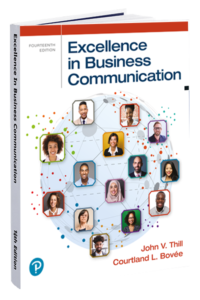
Excellence in Business Communication is the ideal textbook for instructors looking to implement a "frictionless classroom" approach, as described in “The Frictionless Classroom: Transforming Business Communication Education for the Digital Age.” Both the text and the article emphasize removing barriers to effective learning, creating a seamless educational experience that better prepares students for the modern business world.
Here’s how Excellence in Business Communication aligns with the key principles of a frictionless classroom:
1. Embracing the Digital Revolution
The article advocates for updating curricula to reflect the digital tools and communication formats prevalent in today’s workplaces, such as emails, social media, and virtual presentations. Excellence in Business Communication offers this very approach by incorporating digital communication strategies into its lessons. It provides students with real-world applications that go beyond traditional memos and letters, aligning the content with the skills they will need in their professional careers. By utilizing interactive tools, multimedia cases, and online simulations through platforms like MyLab, instructors can seamlessly integrate practical, modern communication tools into the classroom experience.
2. Clear and Open Communication
The article highlights the importance of clear learning objectives and consistent communication between instructors and students. Excellence in Business Communication supports this with detailed chapter objectives, clear learning paths, and rubrics that help students understand exactly what is expected of them. The textbook's integration with digital learning platforms allows for regular feedback loops, helping students stay engaged and reducing the "friction" caused by unclear expectations.
3. Leveraging Digital Tools
Both the article and the textbook stress the importance of mastering digital tools. Excellence in Business Communication integrates features such as real-time collaboration, digital feedback tools, and role-playing scenarios that simulate real-world business environments. These tools allow students to gain hands-on experience with the technology they’ll use in the workplace, helping to bridge the gap between theoretical knowledge and practical application.
4. Balancing Theory and Practice
In the frictionless classroom, theoretical concepts are immediately paired with practical applications. Excellence in Business Communication does this by providing real-world case studies, workplace scenarios, and simulations. Students learn communication theories and immediately put them into practice, whether by drafting emails, preparing presentations, or solving case-based challenges, all of which mirror the complexity of the modern business environment.
5. Bridging the Theory-Practice Gap
The article calls for assignments that mimic workplace scenarios to help students see the relevance of their studies. Excellence in Business Communication excels in this area by including exercises like on-the-job simulations and role-playing activities. These help students practice communication strategies in settings that closely resemble the challenges they will face in their careers, reinforcing the relevance and applicability of their lessons.
6. Encouraging Collaboration and Feedback
In a frictionless classroom, collaboration and peer feedback are crucial to fostering better communication skills. The textbook supports this through interactive learning tools that allow for peer reviews, group projects, and collaborative problem-solving. Students are encouraged to critique each other's work, thereby improving their own communication abilities in a supportive and constructive environment.
Key Takeaways
Excellence in Business Communication embodies the frictionless classroom concept by transforming traditional communication education into an engaging, modern, and practical learning experience. Its digital integration, focus on real-world skills, and emphasis on collaboration all align with the call for a frictionless, student-centered approach. By using this text, instructors can equip their students with the tools, clarity, and skills they need to succeed in today’s fast-paced business environment, reducing friction and unlocking their potential as confident, skilled communicators.
Read more

Teaching business communication is shaped by both obvious elements and subtle influences beneath the surface.
Hidden Forces Shape Business Communication Teaching, Influencing Course Content and Methods
In the ever-evolving field of business communication, educators are influenced by a variety of factors, both visible and invisible. While some influences, such as course content or textbook choices, are immediately apparent, many unseen forces operate beneath the surface, shaping how instructors approach teaching. These indirect forces range from institutional culture to global industry trends, and they play a significant role in determining what and how students learn in business communication courses. Understanding these hidden factors can empower instructors to adapt their teaching practices and create more effective, engaging learning environments.
1. Institutional Culture and Policies
The ethos and values of an educational institution often dictate how business communication is taught. Policies related to grading, classroom behavior, and attendance influence instructors' teaching methods and students' learning experiences. For example, institutions that prioritize experiential learning may encourage more project-based assignments, while more traditional institutions might emphasize lectures and exams.
2. Technological Advancements
As new technologies emerge, they reshape communication practices in the business world and, consequently, what is taught in classrooms. Instructors must stay up-to-date with the latest tools, such as AI-driven communication platforms or collaborative tools like Slack and Zoom. These technological shifts push educators to teach not just theory but practical skills students will need in a rapidly changing digital landscape.
3. Industry Trends
Global shifts in business practices—such as the rise of remote work, corporate social responsibility, or data-driven decision-making—exert a direct influence on the skills and knowledge business communication students need. Instructors must adapt their curriculum to reflect the latest trends, ensuring that students are well-prepared to meet industry demands. This often requires rethinking course materials and embracing emerging topics like sustainability communication or crisis management.
4. Student Expectations and Preferences
Modern students, particularly Gen Z, prefer interactive, digital, and fast-paced learning environments. They expect real-world applications of knowledge, multimedia content, and hands-on experiences that reflect their digital native backgrounds. To meet these expectations, instructors must incorporate technologies like video content, gamification, and peer collaboration into their lessons to maintain engagement and relevance.
5. Accreditation Standards
Accreditation bodies often impose strict standards on business programs, indirectly influencing the teaching of communication skills. These standards may dictate learning outcomes, competencies, and assessment methods, which instructors must align with to ensure program quality and accreditation compliance. This can result in a balancing act between meeting external requirements and maintaining instructional creativity.
6. Socioeconomic Factors
Students come from diverse socioeconomic backgrounds, and this often affects how they approach their education. Those who are balancing work and studies may prefer online or flexible learning models, while others may struggle with access to resources like textbooks or software. Instructors must consider these dynamics and create inclusive environments that accommodate varying levels of access and engagement.

Diverse classrooms demand cultural competence, adapting to varied communication styles for effective cross-cultural teaching.
7. Cultural Diversity
Increasing diversity in classrooms requires instructors to be sensitive to different communication styles, norms, and cultural expectations. Multicultural classrooms provide an opportunity to teach cross-cultural communication but also require careful navigation to avoid misunderstandings or miscommunication. Educators must be culturally competent and flexible, adapting their approach to meet the needs of a diverse student body.
8. Corporate Partnerships and Sponsorships
Collaboration between educational institutions and corporations can shape what is taught in business communication courses. For example, a partnership with a tech company may lead to an emphasis on digital communication tools, while a financial institution's involvement might steer focus toward corporate communication and investor relations. While these partnerships can provide valuable real-world insights, they can also influence the direction of the curriculum in subtle ways.
9. Social Media and Communication Platforms
The rise of platforms like LinkedIn, Instagram, and TikTok has revolutionized the way businesses and professionals communicate. As a result, instructors must teach students how to navigate these platforms effectively, from personal branding to professional networking. Social media also influences teaching methods, as educators incorporate digital platforms into their lessons to help students develop practical communication skills.
10. Unconscious Bias and Instructor Beliefs
Every instructor brings their own experiences, beliefs, and biases into the classroom, often unconsciously shaping their teaching approach. These biases can affect how instructors assess students, how they prioritize content, and how they engage with certain topics. Being aware of these biases and actively working to mitigate them can create a more equitable and inclusive learning environment for all students.
11. Governmental and Educational Policies
Broader policy decisions, such as education funding, curriculum mandates, and federal regulations, can have a significant impact on teaching business communication. For instance, reduced funding may lead to larger class sizes, limiting the opportunities for personalized feedback. Similarly, new educational initiatives may require instructors to integrate specific competencies or technologies into their courses.
12. Crisis Events, Such as Pandemics and Economic Shifts
Global crises like the COVID-19 pandemic or economic recessions often disrupt traditional ways of teaching and practicing business communication. These events force instructors to pivot quickly, adapting their curriculum to address remote communication, crisis management, and digital-first strategies. In turn, students gain exposure to real-world problem-solving in uncertain environments, enhancing their preparedness for the workforce.
13. Peer and Industry Networks
Instructors are influenced by their professional networks, including colleagues, academic associations, and industry experts. These networks serve as a source of inspiration and best practices, helping instructors stay current on the latest trends in business communication. Sharing insights and experiences with peers can lead to the adoption of new teaching methods or tools that improve student outcomes.
14. Hidden Curricula
Beyond the formal curriculum, students absorb implicit lessons about communication norms, professional etiquette, and power dynamics. This "hidden curriculum" can shape their understanding of the business world and influence their communication skills. For example, an instructor's leadership style may teach students more about workplace hierarchy and collaboration than the explicit lesson itself.
15. Algorithmic and Data-Driven Teaching Tools
The rise of AI-powered learning platforms and data analytics has introduced new ways to assess student performance and tailor instruction. These tools can help instructors identify gaps in student knowledge, personalize feedback, and optimize lesson plans based on real-time data. However, the reliance on algorithmic tools also raises questions about equity, privacy, and the balance between human judgment and automated decision-making.
Key Takeaways
The teaching of business communication is shaped by a complex web of unseen forces and indirect influences. From institutional culture to technological advancements, these factors operate behind the scenes, influencing how instructors approach their work and how students engage with the material. By recognizing and understanding these hidden influences, educators can adapt their teaching strategies to create more effective, inclusive, and relevant learning experiences. As business communication continues to evolve, so too must the methods and approaches used to teach it, ensuring that students are prepared for the dynamic challenges of the modern business world.

Why Excellence in Business Communication Is the Ideal Text for Business Communication Instructors
Excellence in Business Communication stands out as the ideal text for instructors because it aligns with the unseen forces shaping modern business communication instruction. This textbook addresses the evolving needs of students and the business landscape by integrating the latest industry trends, such as digital communication, social media, and global collaboration. It provides practical tools that prepare students for the real-world challenges they will face, reflecting the technological advancements that instructors must incorporate into their teaching.
Excellence in Business Communication offers a flexible, adaptable curriculum that allows instructors to meet diverse student expectations and preferences. The text is rich with multimedia content and hands-on exercises, which cater to the interactive, fast-paced learning styles preferred by today’s students. This responsiveness to modern teaching challenges makes it ideal for multicultural classrooms, helping instructors navigate cultural diversity and unconscious biases that can affect learning outcomes.
The textbook’s emphasis on practical application is also aligned with the accreditation standards and institutional policies that shape course design. It ensures that students not only grasp key communication concepts but can also apply them effectively in real-world business settings.
Its focus on crisis communication and digital transformation reflects the need to adapt to crisis events and industry trends, ensuring that students are equipped to handle unpredictable situations in the business world. In short, Excellence in Business Communication is an invaluable resource for instructors seeking to create relevant, engaging, and impactful learning experiences.
Read more
Real-world case studies are the key to unlocking active learning in business communication. By tackling authentic challenges and analyzing actual scenarios, we go beyond theory and develop critical thinking, problem-solving, and communication skills that matter.
In recent years, a prominent theme has emerged in the field of business communication education: a shift away from traditional, lecture-based instruction towards active, experiential learning. This trend reflects a growing understanding that students learn more effectively when they are actively engaged in the learning process, rather than passively receiving information. As business communication is inherently practical and dynamic, the increasing emphasis on real-world application and interactive learning is transforming how the subject is taught.
The Significance of Active, Experiential Learning
The shift towards active learning is significant for several reasons. First, it aligns with broader educational trends that prioritize skills-based education. Employers increasingly seek graduates who are not only knowledgeable but also capable of applying their learning in practical, real-world situations. By incorporating more interactive and experiential elements into business communication courses, instructors can help students develop the critical thinking, problem-solving, and communication skills they will need in the workforce.
Furthermore, this approach enhances student engagement. Passive learning methods, such as lectures, can lead to disengagement and limited retention of material. Active learning strategies, on the other hand, require students to participate, reflect, and apply what they are learning, leading to a deeper understanding of communication principles. Research consistently demonstrates the positive impact of active learning on student engagement, retention, and academic performance. For example, a meta-analysis by Freeman et al. (2014) found that active learning techniques consistently resulted in higher student performance compared to traditional lecture-based instruction.
Examples of the Theme Manifesting in Business Communication Education
Case-Based Learning: One of the most prominent examples of experiential learning in business communication is the increased use of case studies. Students analyze real-world business scenarios and develop communication strategies to solve problems, such as the cases that can be found in Excellence in Business Communication. This method teaches students how to think strategically about communication and adapt their messages for different audiences and contexts. It also gives them hands-on experience in applying theory to practice. Case studies have been widely recognized as a valuable active learning tool in business education, providing students with practical experiences in decision-making and communication within real-world contexts (Schindler, 2017).
Simulations and Role-Playing: Many business communication courses now include simulations where students take on roles in mock business environments. On-the-Job simulations can be found at the end of every chapter in Excellence in Business Communication. For example, students might participate in a crisis communication exercise where they must craft a public relations statement in response to a scandal. This form of active learning not only reinforces communication techniques but also builds soft skills like teamwork, leadership, and emotional intelligence. Simulations provide a safe space for students to practice and develop these skills in a controlled environment before facing them in real-world settings (Mayer, 2004).
Technology Integration: Digital platforms are increasingly being used to facilitate active learning. For instance, some instructors use social media simulations where students create and manage mock company profiles to practice digital communication strategies. Additionally, tools like Slack, Zoom, and collaborative documents encourage interaction and teamwork, even in online or hybrid courses. This integration of technology mirrors the digital communication tools used in modern workplaces, further preparing students for their professional careers. The use of technology in active learning is becoming increasingly prevalent, enabling instructors to create more immersive and engaging learning experiences (Lee, Cho, & Kim, 2018).
Implications for the Future of Teaching Business Communication
The continued emphasis on active, experiential learning will likely shape the future of business communication instruction in several key ways:
Curriculum Design: We will see more curricula designed around projects, case studies, and simulations rather than static, lecture-based modules. Educators will likely develop new ways to assess students’ ability to apply communication theories and strategies in real-world contexts.
Technology as a Learning Enabler: The rise of digital communication tools will continue to expand, with virtual reality (VR) and augmented reality (AR) technologies potentially playing a role in
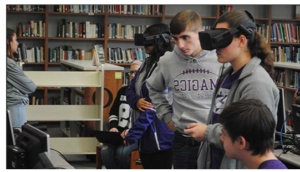
VR/AR simulations offer immersive learning experiences for business communication skills.
simulations for business communication. These tools could allow students to practice presentations, negotiations, or customer relations in immersive environments.
Customized Learning Paths: The trend toward personalized education may also influence the future of business communication. Adaptive learning platforms, such as MyLab for Business Communication, where students can progress at their own pace and receive personalized feedback, is becoming widespread. This enables educators to tailor business communication courses to individual students’ strengths and weaknesses.
Collaboration and Cross-Disciplinary Learning: Business communication will increasingly intersect with other fields, such as digital marketing, leadership studies, and ethics. Cross-disciplinary collaboration will become essential as educators strive to provide students with a more holistic view of communication’s role in the business world.
Leveraging the Theme for Innovation and Growth
To leverage the trend toward active learning for innovation and growth, educators and institutions can take several strategic steps:
Developing Partnerships with Industry: Instructors can collaborate with local businesses or organizations to offer students real-world projects and case studies. This not only gives students valuable experience but also helps them build professional connections. Businesses benefit by gaining fresh perspectives on communication challenges, and educators gain access to up-to-date industry practices.
Expanding Technology Integration: Educational institutions should continue investing in the technology that enables active learning. Tools such as digital whiteboards, project management platforms, and communication simulations can bring the business world into the classroom. Additionally, offering courses that focus on digital communication trends, like social media management and virtual collaboration, will ensure that students are prepared for the modern workplace.
Encouraging Faculty Collaboration: Faculty members from different disciplines—such as communication, marketing, and leadership studies—can work together to design interdisciplinary courses that reflect the interconnected nature of business communication. For example, a course on communication ethics might include case studies from both marketing and human resources to give students a well-rounded view of ethical decision-making in business contexts.
Adapting to Different Learning Styles: By offering a variety of active learning approaches—such as case studies, role-playing, and collaborative projects—educators can cater to different learning styles. This flexibility allows students to engage with material in the way that suits them best, increasing both engagement and retention.
Embracing Active Learning for a Dynamic Future
The shift toward active, experiential learning is one of the most important themes in business communication education today. By focusing on practical, real-world applications of communication skills, educators are better preparing students for the demands of the modern workplace. This trend not only enhances student engagement but also ensures that graduates have the critical thinking, adaptability, and communication skills necessary to succeed.
As the field continues to evolve, educators who embrace this theme can foster innovation and growth in their teaching practices, ultimately creating more dynamic, responsive, and successful business communication programs. By leveraging technology, developing industry partnerships, and offering diverse learning opportunities, instructors can ensure that they remain at the cutting edge of business communication education.

Building Critical Skills with Active Learning: Why Excellence in Business Communication Is Essential
The article emphasizes the growing importance of active learning in business communication, which aligns perfectly with the pedagogical design of Excellence in Business Communication. Here’s why this textbook stands out as the ideal resource in light of these educational trends:
1. Real-World Case Studies for Authentic Learning
The article stresses that real-world case studies are pivotal in fostering critical thinking and problem-solving skills. Excellence in Business Communication excels in this area by offering extensive case studies that challenge students to analyze authentic business scenarios. These cases allow students to go beyond theoretical knowledge and develop practical communication strategies that they can adapt to real-world contexts. As noted in the article, case-based learning has become a hallmark of active learning, helping students gain hands-on experience that mirrors professional situations.
2. Simulations and Role-Playing to Enhance Experiential Learning
One of the most effective forms of active learning mentioned in the article is the use of simulations and role-playing. Excellence in Business Communication integrates On-the-Job simulations at the end of every chapter, offering students opportunities to apply communication principles in simulated business environments. For example, students might engage in crisis communication exercises or take on roles in negotiations, providing them with a safe space to develop and refine their communication skills. These simulations reflect the experiential learning strategies that are crucial for preparing students for the dynamic nature of business communication in the real world.
3. Interactive Learning Tools Aligned with Modern Technology Integration
The increasing use of digital platforms and interactive tools in business communication education is another key trend highlighted in the article. Excellence in Business Communication supports this through its integration with digital learning environments like Pearson’s MyLab. MyLab offers personalized learning paths, adaptive quizzes, and dynamic study modules that allow students to interact with the material in ways that suit their learning styles. This technology-based approach not only enhances engagement but also prepares students to navigate the digital communication tools they will encounter in modern workplaces.
4. Feedback Loops and Student Autonomy for Deeper Engagement
Active learning strategies encourage students to reflect on their learning and apply feedback to improve. Excellence in Business Communication fosters this process by including interactive tools like quizzes, case studies, and personal inventory assessments, which give students immediate feedback on their progress. These tools promote continuous improvement and help students take ownership of their learning, directly addressing the article's emphasis on personalized and adaptive learning.
5. Cross-Disciplinary and Collaborative Learning Opportunities
The article suggests that business communication education will increasingly intersect with other fields, such as ethics, marketing, and leadership. Excellence in Business Communication reflects this trend by incorporating a wide range of topics that encourage students to see communication in a broader, cross-disciplinary context. For example, it explores ethical communication practices, digital media strategies, and leadership communication, allowing students to develop a holistic understanding of how communication impacts various aspects of business operations.
6. Customizable Learning Paths for Diverse Learners
In line with the trend toward customized learning paths mentioned in the article, Excellence in Business Communication provides a range of tools that cater to different learning preferences. Whether students prefer self-paced study, interactive group work, or role-playing exercises, the textbook’s flexible design ensures that all learners can engage with the material in ways that best suit their strengths, ensuring better retention and application of knowledge.
Excellence in Business Communication as the Cornerstone of Active Learning
By incorporating case studies, simulations, technology integration, and customizable learning experiences, Excellence in Business Communication not only aligns with but also enhances the trend toward active, experiential learning in business communication education. It prepares students for the real-world challenges of modern business communication, making it the ideal text for fostering critical skills like problem-solving, adaptability, and communication in today’s dynamic business landscape.
References
Freeman, S., Eddy, S. L., McDonough, M., Smith, M. K., Okoroafor, N., Jordt, H., & Wen, S. (2014). "Active Learning Increases Student Performance in Science, Engineering, and Mathematics." Proceedings of the National Academy of Sciences, 111(23), 8410-8415.
Lee, S., Cho, H., & Kim, J. (2018). "The Impact of Technology Integration on Business Communication Education: A Survey of College Professors." Business Communication Quarterly, 81(2), 168-185.
Mayer, R. E. (2004). "Should There Be a Three-Strikes Rule Against Pure Discovery Learning? The Case for Guided Methods of Instruction." American Psychologist, 59(1), 14-24.
Schindler, P. S. (2017). "The Case Method: A Powerful Tool for Teaching and Learning." Journal of Business Research, 70, 237-242.
Read more
Prioritizing ethics with business communication students creates value and societal impact.
In today's complex business environment, ethical communication challenges pose significant risks to organizational success and stakeholder trust. This comprehensive guide examines 26 critical issues in business communication ethics, from misrepresentation and greenwashing to data privacy and AI bias. Through detailed analysis of real-world cases, ethical considerations, and practical solutions, the document provides essential guidance for business professionals navigating the delicate balance between effective communication and ethical responsibility in an increasingly transparent digital age.
Misrepresentation in Product or Service Communication
Challenge: Deliberately distorting product capabilities, omitting critical limitations, or exaggerating benefits in marketing, sales, or customer communications.
Ethical Considerations:
Short-term gains vs. long-term reputation damage
Legal implications of false advertising
Impact on consumer trust and brand loyalty
Discussion Points and Answers:
Q: How can businesses balance persuasive communication with ethical transparency?
A: Businesses can achieve this balance by focusing on factual product strengths, clearly communicating limitations, and using verifiable claims. They should prioritize educating customers rather than overselling, and implement internal review processes to ensure marketing claims are accurate and ethical.
Q: What are the long-term consequences of misrepresentation on brand equity?
A: Misrepresentation can severely damage brand equity by eroding consumer trust, leading to negative word-of-mouth, decreased customer loyalty, and potential legal issues. This can result in reduced market share, lower sales, and increased marketing costs to rebuild the brand's reputation.
Q: Explore case studies of companies that faced legal action due to misrepresentation.
A: A notable example is the Volkswagen emissions scandal of 2015. The company faced billions in fines, criminal charges against executives, and severe reputational damage after it was discovered they had misrepresented the emissions levels of their diesel vehicles. This case demonstrates how misrepresentation can lead to financial, legal, and long-term brand consequences.
Activity: Develop a comprehensive marketing strategy that highlights product strengths without crossing ethical boundaries.
Intellectual Property Infringement and Plagiarism
Challenge: Unauthorized use of copyrighted material, trademarks, or proprietary information in business communications, reports, or product development.
Ethical Considerations:
Respect for creative and innovative work
Legal ramifications of IP theft
Impact on fair competition and market innovation
Discussion Points and Answers:
Q: How does IP infringement stifle innovation and economic growth?
A: IP infringement discourages innovation by reducing the incentive for companies and individuals to invest in research and development. When ideas are stolen, creators lose potential revenue and motivation to innovate further. This can lead to decreased economic growth as fewer new products and technologies enter the market.
Q: What are the global implications of IP theft in international business?
A: Global IP theft can lead to trade tensions between nations, unfair competition in international markets, and a decrease in foreign direct investment. It can also result in job losses in countries where IP is created and a reduction in global innovation as companies become more protective of their intellectual assets.
Q: Analyze high-profile IP infringement cases and their outcomes.
A: The Apple vs. Samsung patent infringement case is a prime example. It resulted in Samsung paying Apple $539 million for copying iPhone design features. This case highlighted the importance of design patents and set precedents for future technology IP disputes.
Activity: Create a company-wide IP protection and citation policy that ensures ethical use of external sources.
Greenwashing and False Environmental Claims
Challenge: Making unsubstantiated or exaggerated claims about a company's environmental practices, products, or initiatives to capitalize on eco-conscious consumers.
Ethical Considerations:
Environmental responsibility vs. marketing opportunism
Impact on genuine environmental efforts
Consumer trust in sustainability claims
Discussion Points and Answers:
Q: How does greenwashing undermine legitimate environmental initiatives?
A: Greenwashing creates skepticism among consumers, making them less likely to trust genuine environmental claims. This can reduce support for legitimate green initiatives and companies, ultimately slowing progress on environmental issues. It also diverts consumer spending away from truly sustainable products.
Q: What role do third-party certifications play in combating greenwashing?
A: Third-party certifications provide independent verification of environmental claims, increasing credibility and consumer trust. They set standardized criteria for sustainability, making it harder for companies to make false claims. Examples include LEED for buildings, Energy Star for appliances, and Forest Stewardship Council for wood products.
Q: Examine the evolving regulations around environmental marketing claims.
A: Regulations are becoming more stringent globally. The FTC's Green Guides in the US provide guidelines for environmental marketing claims. The EU has introduced the Green Claims Directive to combat greenwashing. These regulations require companies to provide evidence for environmental claims
and use clear, specific language in their marketing.
Activity: Develop a transparent sustainability report that accurately represents a company's environmental impact and initiatives.
Conflicts of Interest in Business Relationships
Challenge: Failing to disclose personal, financial, or professional interests that may influence business decisions, negotiations, or partnerships.
Ethical Considerations:
Transparency in decision-making processes
Fiduciary responsibility to stakeholders
Maintaining objectivity in business relationships
Discussion Points and Answers:
Q: How do undisclosed conflicts of interest erode trust in corporate governance?
A: Undisclosed conflicts of interest can lead to decisions that benefit individuals rather than the company or its stakeholders. This erodes shareholder trust, damages the company's reputation, and can lead to legal issues. It also undermines the integrity of corporate governance systems, making it harder for companies to attract investors and partners.
Q: What are the potential legal consequences of hidden conflicts of interest?
A: Legal consequences can include fines, criminal charges for fraud or breach of fiduciary duty, and civil lawsuits from shareholders or other affected parties. In some cases, contracts or deals made under undisclosed conflicts of interest can be voided. Regulatory bodies may also impose sanctions or increased oversight on the company.
Q: Analyze real-world cases where conflicts of interest led to corporate scandals.
A: The Enron scandal is a classic example. Executives hid conflicts of interest in off-book partnerships, leading to fraudulent financial reporting. This resulted in the company's collapse, criminal convictions for executives, and major changes in corporate governance regulations (e.g., the Sarbanes-Oxley Act).
Activity: Create a comprehensive conflict of interest disclosure policy and reporting system for a multinational corporation.
Data Privacy and Security Breaches
Challenge: Mishandling, misusing, or inadequately protecting customer data, leading to privacy violations or security breaches.
Ethical Considerations:
Balancing data utilization with privacy rights
Transparency in data collection and usage policies
Responsibility in safeguarding sensitive information
Discussion Points and Answers:
Q: How do data breaches impact customer trust and brand reputation?
A: Data breaches severely damage customer trust, often leading to customer churn and negative publicity. They can result in long-term reputational damage, making it difficult to attract new customers and retain existing ones. The financial impact can be significant, including costs of breach mitigation, potential legal action, and lost business.
Q: What are the ethical implications of data monetization?
A: Data monetization raises ethical concerns about consent, privacy, and the potential for exploitation. It questions whether individuals are truly aware of how their data is being used and if they're receiving fair value in exchange. There's also the risk of creating or reinforcing societal inequalities through data-driven decision making.
Q: Examine the evolving landscape of global data protection regulations (e.g., GDPR, CCPA).
A: Global data protection regulations are becoming more stringent. The EU's GDPR set a new standard for data protection, introducing concepts like the right to be forgotten and requiring explicit consent for data collection. The CCPA in California gives consumers more control over their personal data. These regulations are influencing similar laws worldwide, forcing companies to adopt more transparent and responsible data practices.
Activity: Develop a comprehensive data governance framework that addresses collection, storage, usage, and protection of customer information.
Strategic Omission of Critical Information
Challenge: Deliberately withholding crucial information in contracts, negotiations, or stakeholder communications that could significantly influence decision-making.
Ethical Considerations:
Duty of disclosure vs. strategic advantage
Impact on informed consent and fair dealing
Legal implications of material omissions
Discussion Points and Answers:
Q: How does strategic omission differ from lying, and what are the ethical distinctions?
A: Strategic omission involves withholding information, while lying involves actively stating false information. Ethically, both can be considered forms of deception. However, omission is often seen as less severe because it doesn't involve creating false information. The ethical distinction often depends on the materiality of the omitted information and the duty of disclosure in the specific context.
Q: What are the long-term consequences of omission on business relationships and trust?
A: Omission can lead to a breakdown of trust when the withheld information eventually comes to light. This can damage long-term business relationships, lead to contract disputes, and harm a company's reputation for transparency and fair dealing. It may also result in legal consequences if the omission is deemed material to the agreement or transaction.
Q: Analyze legal cases where omissions led to contract nullifications or penalties.
A: In the case of Cigna Corp. v. Audax Health Solutions, Inc., the Delaware Chancery Court ruled that the failure to disclose certain financial information in a merger agreement constituted a material omission. This led to parts of the agreement being deemed unenforceable, highlighting the legal risks of strategic omissions in business transactions.
Activity: Create a transparency checklist for use in high-stakes business negotiations to ensure all critical information is disclosed.
Financial Misrepresentation and Fraudulent Reporting
Challenge: Manipulating financial statements, reports, or projections to present a false picture of a company's financial health or performance.
Ethical Considerations:
Fiduciary duty to shareholders and stakeholders
Integrity of financial markets
Long-term consequences of financial fraud
Discussion Points and Answers:
Q: How does financial misrepresentation impact market efficiency and investor trust?
A: Financial misrepresentation distorts market efficiency by providing false information, leading to misallocation of capital. It erodes investor trust in financial reporting and the market as a whole, potentially increasing the cost of capital for all companies. This can result in reduced market participation and economic growth.
Q: What role do auditors and regulators play in preventing financial fraud?
A: Auditors serve as independent verifiers of financial statements, helping to detect and prevent fraud. Regulators set standards for financial reporting, investigate potential fraud, and enforce penalties for violations. Together, they create a system of checks and balances to maintain the integrity of financial markets and protect investors.
Q: Examine major financial scandals (e.g., Enron, Wirecard) and their lasting impacts.

Wirecard, a German financial company, collapsed after massive fraud was exposed, raising questions about regulatory oversight and auditing practices.
A: The Enron scandal in 2001 led to the collapse of one of America's largest companies and its auditor, Arthur Andersen. It resulted in the Sarbanes-Oxley Act, which significantly increased regulatory oversight of public companies. The Wirecard scandal in 2020 exposed weaknesses in European financial regulation and auditing practices, leading to calls for reform in these areas.
Activity: Develop a robust internal financial control system designed to prevent and detect fraudulent reporting.
Unethical Information Suppression and Censorship
Challenge: Deliberately suppressing or restricting access to information that stakeholders have a right or need to know, often to avoid negative consequences or maintain control.
Ethical Considerations:
Balancing corporate interests with stakeholder rights
Impact on democratic processes and free markets
Long-term consequences of eroded trust
Discussion Points and Answers:
Q: How does corporate censorship affect employee morale and organizational culture?
A: Corporate censorship can lead to a culture of fear and mistrust among employees. It stifles open communication, innovation, and problem-solving. Employees may feel undervalued and disengaged if they perceive that important information is being withheld. This can result in decreased productivity, higher turnover, and a less resilient organization overall.
Q: What are the ethical implications of suppressing negative product information?
A: Suppressing negative product information violates consumer rights to make informed decisions. It can lead to harm if safety issues are concealed, damaging public trust and potentially resulting in legal liabilities. Ethically, it prioritizes short-term corporate interests over consumer welfare and long-term brand integrity.
Q: Analyze cases where information suppression led to public health or safety issues.
A: The Johnson & Johnson talcum powder case is a prime example. The company was accused of suppressing information about asbestos contamination in its products for decades. This led to numerous lawsuits, billions in settlements, and significant reputational damage. It also raised serious public health concerns and eroded trust in the company and the broader consumer products industry.
Activity: Create an ethical framework for information disclosure during corporate crises or product recalls.
Deceptive Corporate Social Responsibility (CSR) Claims
Challenge: Overstating or fabricating CSR initiatives, impact, or commitments to enhance corporate image without making meaningful contributions.
Ethical Considerations:
Authenticity in corporate values and actions
Impact on genuine social and environmental efforts
Long-term consequences on brand trust and reputation
Discussion Points and Answers:
Q: How do false CSR claims undermine the credibility of legitimate social initiatives?
A: False CSR claims create skepticism among consumers and stakeholders, making it harder for genuine initiatives to gain support and recognition. This can lead to reduced overall engagement with CSR efforts, hindering progress on important social and environmental issues. It also creates an unfair competitive advantage for companies making false claims over those investing in real CSR initiatives.
Q: What role should third-party verification play in CSR reporting?
A: Third-party verification adds credibility to CSR claims by providing independent assessment and validation. It helps standardize reporting metrics, making it easier for stakeholders to compare different companies' efforts. Third-party verification can also help identify areas for improvement and ensure companies are held accountable for their CSR commitments.
Q: Examine the evolution of CSR from philanthropy to integrated business strategy.
A: CSR has evolved from simple corporate philanthropy to a more integrated approach that aligns social and environmental efforts with core business strategies. This shift reflects growing recognition that sustainable business practices can create long-term value. Modern CSR often involves stakeholder engagement, sustainability initiatives, and efforts to address systemic issues related to a company's operations and industry.
Activity: Develop a comprehensive CSR strategy with measurable goals, transparent reporting, and stakeholder engagement mechanisms.
Cross-Cultural Communication Negligence
Challenge: Failing to adapt communication strategies to respect cultural norms, values, and sensitivities in global business interactions.
Ethical Considerations:
Respect for diversity and cultural identities
Impact on international business relationships
Potential for unintended offense or miscommunication
Discussion Points and Answers:
Q: How does cultural insensitivity affect global brand perception?
A: Cultural insensitivity can severely damage a brand's global reputation, leading to boycotts, negative publicity, and loss of market share in affected regions. It can be perceived as a form of corporate arrogance or ignorance, damaging relationships with local partners, employees, and customers. Recovery from such incidents often requires significant time and resources.
Q: What are the ethical implications of imposing one's cultural norms in international business?
A: Imposing cultural norms can be seen as a form of cultural imperialism, disrespecting local values and practices. It can lead to misunderstandings, conflict, and missed business opportunities. Ethically, it raises questions about respect for diversity and the balance between maintaining corporate values and adapting to local contexts.
Q: Analyze cases where cultural missteps led to significant business losses or diplomatic tensions.
A: Dolce & Gabbana's 2018 ad campaign in China, which was perceived as racist and culturally insensitive, led to a boycott of the brand in one of its largest markets. The incident resulted in canceled fashion shows, pulled products from retailers, and a significant drop in sales. It highlighted the importance of cultural sensitivity in global marketing and the rapid impact of social media on brand perception.
Activity: Create a comprehensive cross-cultural communication training program for a global corporation.
Unethical Crisis Communication and Cover-ups
Challenge: Deliberately misleading stakeholders during crises, attempting to cover up mistakes, or deflecting responsibility to protect corporate interests.
Ethical Considerations:
Balancing damage control with honesty and transparency
Long-term impact on stakeholder trust
Legal and reputational risks of cover-ups
Discussion Points and Answers:
Q: How does unethical crisis communication affect long-term brand recovery?
A: Unethical crisis communication can prolong and exacerbate the negative impact of a crisis
Discussion Points and Answers:
Q: How does unethical crisis communication affect long-term brand recovery?
A: Unethical crisis communication can prolong and exacerbate the negative impact of a crisis. It erodes stakeholder trust, making brand recovery more difficult and costly. When the truth eventually emerges, as it often does, the company faces a double crisis: the original issue and the cover-up. This can lead to long-term reputational damage, legal consequences, and loss of market share that may take years to recover from, if at all.
Q: What are the ethical obligations of leadership during corporate crises?
A: Leadership has an ethical obligation to prioritize transparency, take responsibility for the situation, and act in the best interests of all stakeholders. This includes promptly disclosing relevant information, showing genuine concern for those affected, and taking decisive action to address the crisis. Leaders should also foster a culture of ethical decision-making that prevents crises and encourages open communication when issues arise.
Q: Compare crisis responses in high-profile cases (e.g., Johnson & Johnson Tylenol vs. BP Deepwater Horizon).
A: The Johnson & Johnson Tylenol crisis of 1982 is often cited as an exemplary response. The company immediately recalled all products, communicated transparently, and prioritized consumer safety over short-term profits. This approach helped the brand recover quickly. In contrast, BP's response to the Deepwater Horizon oil spill in 2010 was criticized for downplaying the severity of the spill, shifting blame, and lack of CEO empathy. This led to long-term reputational damage and massive financial losses.
Activity: Develop a comprehensive crisis communication plan that prioritizes transparency, accountability, and stakeholder interests.
Supply Chain Opacity and Ethical Sourcing Violations
Challenge: Concealing unethical practices in the supply chain, such as labor exploitation, environmental damage, or use of conflict materials.
Ethical Considerations:
Corporate responsibility beyond direct operations
Impact on global labor standards and environmental protection
Consumer right to informed purchasing decisions
Discussion Points and Answers:
Q: How does supply chain transparency affect brand value and consumer loyalty?
A: Supply chain transparency can significantly enhance brand value by demonstrating commitment to ethical practices. Consumers increasingly value brands that are open about their sourcing and manufacturing processes. Transparency builds trust and can lead to increased customer loyalty, as consumers feel more confident in their purchasing decisions. Conversely, lack of transparency or exposed unethical practices can lead to boycotts, loss of market share, and long-term brand damage.
Q: What are the challenges and benefits of implementing ethical sourcing practices?
A: Challenges include increased costs, complexity in monitoring global supply chains, and potential resistance from suppliers or business partners. Benefits include improved risk management, enhanced brand reputation, better quality control, and potential for innovation through closer supplier relationships. Ethical sourcing can also lead to more stable and resilient supply chains, reducing the risk of disruptions due to labor issues or environmental concerns.
Q: Examine the evolution of supply chain due diligence regulations globally.
A: Supply chain due diligence regulations have become increasingly stringent. The UK Modern Slavery Act (2015) and California Transparency in Supply Chains Act (2010) require companies to disclose efforts to eliminate slavery and human trafficking from their supply chains. The EU's proposed mandatory human rights due diligence law would require companies to identify and address human rights and environmental risks in their supply chains. These regulations reflect growing expectations for corporate accountability throughout the entire value chain.
Activity: Create a comprehensive ethical sourcing strategy and supplier code of conduct for a multinational corporation.
Workplace Conditions and Labor Rights Misrepresentation
Challenge: Misrepresenting or concealing information about working conditions, wages, benefits, or labor practices, particularly in global operations.
Ethical Considerations:
Human rights and dignity in the workplace
Fair labor practices and living wages
Transparency in employee communications
Discussion Points and Answers:
Q: How do labor rights violations impact brand reputation and employee productivity?
A: Labor rights violations can severely damage brand reputation, leading to consumer boycotts, negative media coverage, and difficulty in attracting talent. This reputational damage can result in lost sales and decreased market value. In terms of employee productivity, violations often lead to low morale, high turnover, and reduced engagement. Employees who feel exploited or undervalued are less likely to be productive or contribute to innovation, ultimately impacting the company's performance.
Q: What are the ethical implications of outsourcing to countries with weaker labor laws?
A: Outsourcing to countries with weaker labor laws raises ethical concerns about exploiting vulnerable workers and perpetuating global inequality. It can be seen as prioritizing cost savings over human rights and dignity. Ethically, companies have a responsibility to ensure fair treatment of workers throughout their supply chain, regardless of local legal standards. Failure to do so can lead to accusations of corporate neo-colonialism and contribute to a race to the bottom in global labor standards.
Q: Analyze cases where exposure of poor working conditions led to consumer boycotts or legal action.
A: The 2013 Rana Plaza collapse in Bangladesh, which killed over 1,100 garment workers, led to global outrage and consumer boycotts of fashion brands associated with the factory. This resulted in the creation of the Bangladesh Accord on Fire and Building Safety, a legally binding agreement to improve worker safety. Similarly, exposés of poor working conditions in Apple's supplier factories in

Apple supplier exposés spurred industry-wide labor reforms in tech supply chains.
China led to increased scrutiny, third-party audits, and improved labor practices throughout the tech industry supply chain.
Activity: Develop a global labor rights compliance program and transparent reporting system for a multinational corporation.
Competitive Defamation and Unethical Comparative Advertising
Challenge: Making false, misleading, or malicious statements about competitors to gain market advantage or damage their reputation.
Ethical Considerations:
Fair competition and market integrity
Consumer right to accurate information
Legal boundaries of comparative advertising
Discussion Points and Answers:
Q: How does unethical competitive communication impact industry credibility?
A: Unethical competitive communication can erode trust in the entire industry, not just the companies involved. When consumers are exposed to conflicting claims and accusations, it can lead to skepticism about all industry messaging. This loss of credibility can result in decreased consumer confidence, increased regulatory scrutiny, and a more challenging business environment for all players in the industry.
Q: What are the long-term consequences of engaging in "mudslinging" campaigns?
A: While mudslinging campaigns might offer short-term gains, they often lead to long-term negative consequences. These can include damaged industry relationships, reciprocal negative campaigns from competitors, and a race to the bottom in terms of advertising ethics. Companies engaging in mudslinging may find it difficult to form partnerships or collaborations in the future. Moreover, consumers may develop a negative perception of the brand as petty or unprofessional, leading to decreased brand loyalty and sales.
Q: Examine legal cases that have shaped the boundaries of comparative advertising.
A: The Pizza Hut, Inc. v. Papa John's International, Inc. case in 2000 set important precedents for comparative advertising in the US. The court ruled that Papa John's slogan "Better Ingredients. Better Pizza." was not false or misleading advertising, emphasizing that puffery (exaggerated advertising claims) is protected speech. However, the case also highlighted that specific comparative claims must be substantiated. In Europe, the 2006 EU Directive on Misleading and Comparative Advertising provides a framework for acceptable comparative advertising, requiring it to be objective and verifiable.
Activity: Create ethical guidelines for competitive communication and comparative advertising within a specific industry.
Workplace Harassment Policy Failures
Challenge: Inadequately communicating, enforcing, or following through on workplace harassment policies, leading to hostile work environments.
Ethical Considerations:
Employee safety and well-being
Equal opportunity and non-discrimination
Corporate culture and values alignment
Discussion Points and Answers:
Q: How do harassment policy failures impact employee retention and productivity?
A: Harassment policy failures can lead to increased employee turnover as victims and witnesses of harassment seek safer work environments. This results in higher recruitment and training costs. Productivity suffers as employees experiencing or witnessing harassment may be distracted, stressed, or disengaged. The fear of reporting incidents can create a culture of silence, hindering collaboration and innovation. Overall, these failures can significantly impact a company's bottom line through decreased productivity, increased absenteeism, and potential legal costs.
Q: What are the legal and reputational risks of inadequate harassment prevention?
A: Legally, companies can face costly lawsuits, regulatory fines, and government investigations for failing to prevent harassment. High-profile cases can lead to significant financial settlements and legal fees. Reputationally, companies may struggle to attract top talent, lose current employees, and face negative media coverage. Consumer boycotts and investor concerns can also arise, potentially impacting stock prices and market share. The long-term cost of reputational damage often far exceeds the immediate legal consequences.
Q: Analyze high-profile cases where harassment allegations led to significant corporate changes.
A: The #MeToo movement brought several high-profile cases to light. For example, the sexual harassment allegations at Uber in 2017 led to the CEO's resignation and a complete overhaul of the company's corporate culture. Similarly, allegations at Fox News resulted in the departure of key executives, including Roger Ailes, and led to new company-wide harassment training and reporting procedures. These cases demonstrate how harassment issues can lead to leadership changes, policy reforms, and shifts in corporate culture.
Activity: Develop a comprehensive anti-harassment program including policy communication, training, reporting mechanisms, and enforcement procedures.
Public Relations Manipulation and Spin Doctoring
Challenge: Using deceptive communication strategies to distort public perception, minimize negative events, or exaggerate positive attributes.
Ethical Considerations:
Transparency and honesty in public communications
Media integrity and public trust
Long-term consequences of manipulative practices
Discussion Points and Answers:
Q: How does PR manipulation erode public trust in institutions and media?
A: PR manipulation can lead to a general skepticism towards all corporate communications and media reports. When the public becomes aware of spin tactics, they may start to question the authenticity of all information, even from legitimate sources. This erosion of trust can extend beyond the specific company to affect entire industries or even democratic institutions. In the long term, it contributes to a post-truth environment where facts become less important than emotional appeals or personal beliefs.
Q: What are the ethical boundaries between positive framing and deception?
A: Positive framing involves presenting factual information in a favorable light, while deception involves distorting or omitting crucial facts. The ethical boundary lies in the truthfulness and completeness of the information presented. It's generally considered ethical to emphasize positive aspects as long as negative aspects are not hidden or misrepresented. The key is to provide stakeholders with all the information necessary to make informed decisions, even if that information is presented in a way that highlights positives.
Q: Examine cases where PR spin backfired, leading to greater reputational damage.
A: BP's handling of the Deepwater Horizon oil spill in 2010 is a classic example. The company's attempts to downplay the severity of the spill and CEO Tony Hayward's comment that he'd "like his life back" were seen as insensitive and dishonest. This PR approach backfired, leading to intense public backlash and long-term reputational damage. Similarly, Volkswagen's initial attempts to minimize the 2015 emissions scandal through PR spin only served to heighten public outrage when the full extent of the deception was revealed.
Activity: Create ethical guidelines for crisis communication that balance reputation management with transparency and accountability.
Overpromising in Product Development and Marketing
Challenge: Making unrealistic claims or commitments about future products, features, or performance to generate hype or secure investments.
Ethical Considerations:
Managing stakeholder expectations responsibly
Impact on consumer trust and brand credibility
Potential for market manipulation
Discussion Points and Answers:
Q: How does overpromising affect long-term customer relationships and brand loyalty?
A: Overpromising can lead to customer disappointment and erode trust when products fail to meet inflated expectations. This can result in negative word-of-mouth, decreased repeat purchases, and damage to brand loyalty. Customers who feel misled are less likely to engage with future products or marketing campaigns. Over time, a pattern of overpromising can lead to a cynical customer base and a reputation for unreliability, making it difficult to generate excitement for genuine innovations.
Q: What are the legal risks associated with unfulfilled product promises?
A: Unfulfilled product promises can lead to legal actions for false advertising, fraud, or breach of contract. Class-action lawsuits from consumers or shareholders can result in significant financial penalties and legal costs. Regulatory bodies like the FTC in the US can impose fines and require corrective advertising. In severe cases, executives could face personal liability. Additionally, failing to meet promised product specifications could lead to contract disputes with business partners or retailers.
Q: Analyze cases in the tech industry where overpromising led to significant backlash or legal consequences.
A: Theranos is a prime example, where exaggerated claims about blood-testing technology led to a multi-billion dollar fraud case. The company's founder, Elizabeth Holmes, was convicted on multiple counts of fraud. Another case is No Man's Sky, a video game that failed to deliver on many pre-release promises, leading to investigations by the UK's Advertising Standards Authority and a significant backlash from consumers. While the game eventually improved, the initial overpromising damaged the developer's reputation and sales.
Activity: Develop an ethical framework for communicating about products in development, balancing excitement with realistic expectations.
Astroturfing and Fake Grassroots Movements
Challenge: Creating or funding fake grassroots movements or user-generated content to manipulate public opinion or create false impressions of support.
Ethical Considerations:
Authenticity in public discourse
Manipulation of democratic processes
Transparency in advocacy and marketing
Discussion Points and Answers:
Q: How does astroturfing undermine genuine public opinion and policy-making?
A: Astroturfing distorts the true nature of public sentiment, potentially leading to policies or decisions that don't reflect actual public interest. It can drown out genuine grassroots movements and citizen voices, skewing the democratic process. By creating a false sense of consensus or controversy, astroturfing can manipulate media coverage, influence lawmakers, and mislead other stakeholders. This undermines the principles of transparent, fact-based decision-making in both public policy and consumer choices.
Q: What are the ethical implications of using social media bots or paid influencers without disclosure?
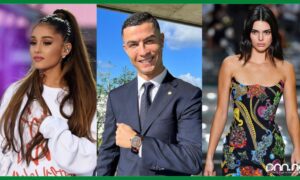
Ethical, legally-compliant influencer marketing builds trust, protects interests, and achieves sustainable success.
A: Using undisclosed bots or paid influencers violates principles of transparency and authenticity in communication. It deceives audiences about the source and motivation behind messages, manipulating the perceived popularity or credibility of ideas or products. This practice erodes trust in social media platforms and online discourse. Ethically, it raises questions about the integrity of public debate, the right to informed decision-making, and the responsible use of technology in shaping public opinion.
Q: Examine cases where astroturfing campaigns were exposed and the resulting consequences.
A: The "Working Families for Walmart" campaign in 2006 was exposed as an astroturfing effort by Walmart and its PR firm. This fake grassroots group, supposedly supporting Walmart's labor practices, was revealed to be corporate-funded, leading to negative publicity and decreased public trust. Another example is the New York Attorney General's 2013 investigation into fake online reviews, which resulted in 19 companies paying over $350,000 in fines. These cases highlight the reputational and legal risks of astroturfing, as well as the increasing scrutiny of such practices by regulators and the public.
Activity: Create a social media engagement policy that ensures authentic interactions and transparent disclosures of corporate involvement.
Exploitation of Vulnerable Populations in Marketing
Challenge: Targeting vulnerable groups (e.g., children, elderly, financially distressed) with manipulative or predatory marketing tactics.
Ethical Considerations:
Protection of vulnerable consumers
Responsible marketing practices
Social responsibility in business
Discussion Points and Answers:
Q: How does exploitative marketing impact societal well-being and consumer trust?
A: Exploitative marketing can exacerbate societal inequalities and harm vulnerable individuals. It can lead to financial hardship, health issues, or other negative outcomes for those least able to protect themselves. This erodes overall consumer trust in marketing and business practices, potentially leading to increased regulation and a more adversarial relationship between businesses and consumers. Long-term, it can contribute to social problems and economic instability, which negatively impacts the business
Discussion Points and Answers:
Q: How does exploitative marketing impact societal well-being and consumer trust?
A: Exploitative marketing can exacerbate societal inequalities and harm vulnerable individuals. It can lead to financial hardship, health issues, or other negative outcomes for those least able to protect themselves. This erodes overall consumer trust in marketing and business practices, potentially leading to increased regulation and a more adversarial relationship between businesses and consumers. Long-term, it can contribute to social problems and economic instability, which negatively impacts the business environment for all companies.
Q: What are the ethical boundaries for marketing to different demographic groups?
A: Ethical marketing should respect the autonomy and well-being of all demographic groups. For children, this means avoiding manipulative tactics that exploit their developmental vulnerabilities. For the elderly, it involves clear communication and avoiding high-pressure sales tactics. For financially distressed individuals, it means refraining from promoting products that could worsen their situation. The key is to provide honest, clear information that allows informed decision-making, while avoiding exploitation of group-specific vulnerabilities.
Q: Analyze regulatory changes aimed at protecting vulnerable consumers in various industries.
A: Many countries have implemented regulations to protect vulnerable consumers. In the U.S., the Children's Online Privacy Protection Act (COPPA) restricts data collection from children under 13. The EU's Unfair Commercial Practices Directive prohibits aggressive marketing to vulnerable groups. In financial services, regulations like the Credit CARD Act of 2009 in the U.S. limit credit card marketing on college campuses.These regulations reflect growing awareness of the need to protect vulnerable consumers from exploitative marketing practices.
Activity: Develop ethical marketing guidelines for reaching diverse demographics without exploitation.
Undisclosed Influencer Partnerships and False Endorsements
Challenge: Failing to disclose paid partnerships with influencers or creating false impressions of celebrity endorsements.
Ethical Considerations:
Transparency in advertising
Consumer right to informed decision-making
Authenticity in social media marketing
Discussion Points and Answers:
Q: How do undisclosed partnerships affect consumer trust and influencer credibility?
A: Undisclosed partnerships erode consumer trust by misleading audiences about the nature of the endorsement. When consumers discover that what they perceived as genuine recommendations were actually paid advertisements, it can lead to feelings of betrayal and skepticism towards both the brand and the influencer. This damages the credibility of influencer marketing as a whole and can lead to a cycle of diminishing returns as consumers become more cynical about all forms of social media endorsement.
Q: What are the evolving regulations around influencer marketing disclosures?
A: Regulations are becoming more stringent globally. In the U.S., the FTC requires clear and conspicuous disclosure of material
connections between influencers and brands. The use of hashtags like #ad or #sponsored is common, but the FTC emphasizes that disclosures must be unambiguous and easily noticed. The UK's Advertising Standards Authority (ASA) has similar guidelines. The EU has been working on harmonizing influencer marketing rules across member states, focusing on transparency and clear labeling of commercial content.
Q: Examine cases where false or undisclosed endorsements led to legal action or public backlash.
A: In 2017, the Fyre Festival case highlighted the risks of undisclosed influencer partnerships. Numerous influencers were criticized and some faced legal action for promoting the fraudulent festival without proper disclosures. In 2019, the U.S. FTC settled with individual influencers for the first time over undisclosed endorsements in the gaming industry. These cases have led to increased scrutiny of influencer marketing practices and pushed both brands and influencers to be more transparent about their relationships.
Activity: Create a comprehensive influencer partnership program with clear disclosure policies and content guidelines.
Internal Communication Manipulation
Challenge: Withholding or distorting information communicated to employees about company performance, restructuring, or future plans.
Ethical Considerations:
Employee right to information affecting their livelihoods
Trust and transparency in organizational culture
Balancing confidentiality with openness
Discussion Points and Answers:
Q: How does internal communication manipulation impact employee morale and productivity?
A: Manipulating internal communications can severely damage employee trust, leading to decreased morale and productivity. When employees feel they're not getting the full picture, it can create anxiety, reduce engagement, and foster a culture of rumors and speculation. This can result in decreased job satisfaction, higher turnover rates, and reduced overall productivity as employees spend time and energy trying to discern the truth or prepare for perceived threats to their job security.
Q: What are the ethical obligations of leadership in communicating difficult news?
A: Leadership has an ethical obligation to communicate difficult news with honesty, clarity, and empathy. While timing and manner of communication may need to be strategic, the information should be accurate and complete. Leaders should provide context for decisions, acknowledge the impact on employees, and offer support or resources where possible. Transparency in such situations, even when the news is negative, can help maintain trust and respect within the organization.
Q: Analyze cases where leaked internal communications contradicted public statements, and the resulting fallout.
A: The Volkswagen emissions scandal provides a notable example. Internal communications revealed that executives were aware of the emissions cheating software long before it became public, contradicting the company's initial public statements of surprise and ignorance. This discrepancy severely damaged the company's credibility, led to legal consequences, and worsened the overall impact of the scandal. Similarly, leaked internal emails from Facebook (now Meta) during the Cambridge Analytica scandal revealed a deeper awareness of data privacy issues than was publicly acknowledged, further eroding public trust in the company.
Activity: Develop an internal communication strategy that prioritizes transparency while managing sensitive information responsibly.
Coercive Negotiation Tactics
Challenge: Using threats, intimidation, or manipulation in business negotiations to force unfavorable terms on weaker parties.
Ethical Considerations:
Fair dealing and good faith in business relationships
Power dynamics in negotiations
Long-term consequences of coercive practices
Discussion Points and Answers:
Q: How do coercive tactics impact long-term business relationships and reputation?
A: Coercive tactics may yield short-term gains but often damage long-term business relationships. They create resentment, erode trust, and can lead to retaliation or termination of business relationships when the opportunity arises. Companies known for such practices may find it difficult to form new partnerships or retain existing ones. This can result in a reputation for being a difficult or unethical business partner, potentially limiting future opportunities and collaborations.
Q: What are the ethical boundaries of hard negotiation vs. coercion?
A: Hard negotiation involves assertively pursuing one's interests within the bounds of fairness and respect. It can include tactics like anchoring, strategic concessions, or leveraging alternatives. Coercion, on the other hand, involves threats, intimidation, or abuse of power to force agreement. The ethical boundary lies in respecting the other party's autonomy and right to make informed decisions. Ethical negotiation should aim for mutually beneficial outcomes and maintain the integrity of the business relationship.
Q: Examine legal cases that have addressed coercive business practices.
A: The case of ITT Continental Baking Co. v. FTC (1984) addressed coercive practices in retail shelf space allocation, where the court ruled against using market power to force unfair terms on retailers. In labor law, NLRB v. Gissel Packing Co. (1969) set precedents against coercive tactics in union negotiations. These cases highlight that while aggressive negotiation is generally acceptable, tactics that cross into coercion or exploitation of significant power imbalances can be legally actionable.
Activity: Create a framework for ethical negotiation that emphasizes mutual benefit and respect for all parties.
High-Pressure Sales Techniques
Challenge: Using aggressive or manipulative communication to pressure customers into making quick, uninformed purchase decisions.
Ethical Considerations:
Respect for consumer autonomy
Transparency in sales processes
Building long-term customer relationships
Discussion Points and Answers:
Q: How do high-pressure sales tactics impact brand reputation and customer loyalty?
A: High-pressure sales tactics often lead to negative customer experiences, damaging brand reputation and reducing customer loyalty. Customers who feel coerced into purchases are more likely to experience buyer's remorse, leading to returns, negative reviews, and word-of-mouth criticism. This can result in a loss of repeat business and difficulty attracting new customers. Long-term, these tactics can create a reputation for untrustworthiness, significantly impacting the brand's market position and customer acquisition costs.
Q: What are the psychological effects of pressure selling on consumers?
A: Pressure selling can induce stress, anxiety, and cognitive overload in consumers. This can lead to impulsive decisions that the consumer later regrets. The psychological discomfort associated with these tactics can create negative associations with the brand or product. Some consumers may experience feelings of manipulation or violation, leading to distrust of sales processes in general. These negative experiences can result in avoidance behaviors, where consumers actively stay away from situations where they might encounter such tactics.
Q: Analyze industries where pressure selling is prevalent and regulatory responses.
A: Pressure selling has been particularly prevalent in industries such as timeshare sales, car dealerships, and some financial services. In response, many jurisdictions have implemented "cooling off" periods for certain types of sales, allowing consumers to cancel contracts within a specified timeframe. The EU's Consumer Rights Directive, for example, provides a 14-day right of withdrawal for many types of contracts. In the U.S., the FTC's Cooling-Off Rule gives consumers a 3-day right to cancel certain sales. These regulations aim to protect consumers from the negative effects of high-pressure sales tactics.
Activity: Develop a customer-centric sales approach that prioritizes informed decision-making and long-term satisfaction.
AI and Automation Bias in Communication
Challenge: Failing to address or disclose potential biases in AI-driven communication systems, leading to unfair or discriminatory outcomes.
Ethical Considerations:
Fairness and non-discrimination in automated systems
Transparency in AI decision-making processes
Human oversight and accountability
Discussion Points and Answers:
Q: How can companies ensure ethical use of AI in customer interactions and decision-making?
A: Companies can ensure ethical AI use by implementing rigorous testing for bias, regularly auditing AI systems, and maintaining human oversight. This includes using diverse data sets in AI training, involving multidisciplinary teams in AI development, and establishing clear ethical guidelines for AI use. Transparency is crucial – companies should be open about where and how AI is being used in customer interactions. Additionally, providing mechanisms for customers to appeal AI-driven decisions and maintaining the option for human intervention can help mitigate potential harms.
Q: What are the potential consequences of unchecked AI bias in business processes?
A: Unchecked AI bias can lead to discriminatory outcomes in areas such as hiring, lending, or customer service, potentially violating anti-discrimination laws and ethical standards. This can result in legal liabilities, reputational damage, and loss of customer trust. On a broader scale, it can perpetuate or exacerbate existing societal inequalities. In business processes, biased AI can lead to suboptimal decision-making, missed opportunities, and the alienation of certain customer segments or employee groups.
Q: Examine cases where AI systems have demonstrated bias and the resulting controversies.
A: A notable case is Amazon's experimental AI recruiting tool that showed bias against women candidates. The system, trained on historical hiring data, penalized resumes that included the word "women's" or mentioned all-women's colleges. This led to the tool being abandoned and highlighted the risks of AI perpetuating historical biases. Another example is the controversy surrounding facial recognition systems that have shown higher error rates for people of color, leading to concerns about their use in law enforcement and security applications. These cases have spurred increased scrutiny and calls for regulation of AI systems in high-stakes decision-making processes.
Activity: Create an ethical AI framework for business communication that addresses bias, transparency, and human oversight.
Misleading Investor Communications
Challenge: Providing selective, overly optimistic, or misleading information to investors about company performance, risks, or future prospects.
Ethical Considerations:
Fiduciary duty to shareholders
Market integrity and fair disclosure
Balancing optimism with realistic projections
Discussion Points and Answers:
Q: How does misleading investor communication impact market efficiency and capital allocation?
A: Misleading investor communications can lead to inefficient capital allocation as investors make decisions based on inaccurate information. This can result in overvaluation of companies, misallocation of resources, and potential market bubbles. When the truth eventually emerges, it can lead to sharp corrections, eroding investor wealth and confidence. In the long term, such practices can undermine the integrity of financial markets, increasing the cost of capital for all companies and reducing overall economic efficiency.
Q: What are the legal and reputational risks of overly optimistic forecasts?
A: Overly optimistic forecasts can lead to accusations of securities fraud, resulting in regulatory investigations, fines, and shareholder lawsuits. The Sarbanes-Oxley Act in the U.S. imposes severe penalties for knowingly certifying inaccurate financial statements. Reputationally, companies known for consistently missing their forecasts may lose credibility with investors and analysts, leading to lower valuations and increased scrutiny of future communications. This can create a cycle of distrust, making it harder for the company to raise capital or maintain stable stock prices.
Q: Examine high-profile cases of investor fraud and their impact on market regulations.
A: The Enron scandal of 2001 is a classic example, where fraudulent accounting practices led to one of the largest bankruptcies in U.S. history. This case resulted in the passage of the Sarbanes-Oxley Act, significantly increasing regulatory oversight and penalties for financial fraud. More recently, the Theranos case, where investors were misled about the capabilities of blood-testing technology, has led to increased scrutiny of private company valuations and calls for more transparency in startup reporting. These cases have shaped modern financial regulations and heightened awareness of the importance of accurate investor communications.
Activity: Create an ethical framework for investor relations that emphasizes transparency, accuracy, and balanced reporting.
Disinformation Campaigns and Corporate Propaganda
Challenge: Deliberately spreading false or misleading information to shape public opinion, influence policy, or damage competitors.
Ethical Considerations:
Corporate responsibility in public discourse
Impact on democratic processes and informed decision-making
Long-term consequences on societal trust
Discussion Points and Answers:
Q: How do corporate disinformation campaigns undermine public trust in institutions?
A: Corporate disinformation campaigns erode public trust not just in the companies involved, but in institutions more broadly. When exposed, these campaigns can lead to increased skepticism towards all corporate communications, media reports, and even scientific findings. This contributes to a "post-truth" environment where factual information is devalued. The resulting erosion of trust can extend to governmental, educational, and other societal institutions, potentially undermining the foundations of informed public discourse and democratic decision-making.
Q: What are the ethical implications of using dark money or front groups to spread messages?
A: Using dark money or front groups to spread messages violates principles of transparency and accountability in public discourse. It denies the public the ability to consider the source and potential biases of information, manipulating the marketplace of ideas. Ethically, it represents a form of deception that can distort public policy debates and democratic processes. It also raises questions about corporate ethics and the appropriate role of businesses in shaping public opinion, potentially crossing the line from legitimate advocacy to manipulative propaganda.
Q: Analyze cases where disinformation campaigns were exposed and the resulting fallout.
A: The tobacco industry's decades-long campaign to dispute the health risks of smoking is a classic example. When internal documents revealed the industry's knowledge of these risks and deliberate efforts to mislead the public, it led to massive lawsuits, regulatory crackdowns, and a permanent loss of public trust. More recently, fossil fuel companies have faced similar scrutiny for campaigns disputing climate change, leading to legal challenges and reputational damage. These cases have heightened public awareness of corporate disinformation tactics and increased calls for accountability in corporate communications.
Activity: Create an ethical framework for corporate communications that emphasizes fact-checking, transparency, and responsible information sharing.
Key Takeaways
These 26 enhanced ethical issues in business communication represent critical challenges that modern organizations face in maintaining integrity, trust, and responsible practices. By addressing these issues proactively, companies can build stronger relationships with stakeholders, mitigate risks, and contribute to a more ethical business environment.
Key takeaways for business communication students and professionals:
Prioritize transparency and honesty in all communications, even when it's challenging.
Consider the long-term consequences of communication decisions on trust and reputation.
Develop strong ethical frameworks and guidelines for various communication scenarios.
Stay informed about evolving regulations and best practices in business communication ethics.
Foster a culture of ethical communication within organizations, encouraging open dialogue about ethical challenges.
Regularly assess and update communication strategies to address new ethical concerns in a rapidly changing business landscape.
Embrace technological advancements while being mindful of their ethical implications, particularly in areas like AI and data privacy.
Recognize the global impact of communication decisions and respect cultural differences in ethical standards.
Prioritize stakeholder interests and societal well-being over short-term corporate gains.
Develop crisis communication plans that emphasize transparency, accountability, and ethical decision-making.
By focusing on these enhanced ethical issues, business communication students and professionals can develop the skills and awareness necessary to navigate complex ethical dilemmas, ultimately contributing to more responsible and trustworthy business practices.
The evolving nature of business communication, driven by technological advancements and changing societal expectations, means that ethical considerations will continue to be at the forefront of professional practice. As future business leaders, it's crucial to not only understand these ethical issues but to actively work towards creating organizational cultures that value and prioritize ethical communication.
Remember that ethical business communication is not just about avoiding negative consequences; it's about building trust, fostering positive relationships, and contributing to a more transparent and responsible business environment. By doing so, organizations can create long-term value for all stakeholders and play a positive role in shaping the future of business and society.
Final Recommendations
Integrate ethical communication training into all levels of business education and professional development programs.
Encourage interdisciplinary approaches to addressing ethical issues, combining insights from business, ethics, psychology, and technology fields.
Promote industry-wide standards and best practices for ethical communication, possibly through professional associations or collaborative initiatives.
Support research into emerging ethical challenges in business communication, particularly those arising from new technologies and changing social norms.
Advocate for policies and regulations that promote ethical business communication practices while balancing the need for innovation and competitive markets.
By addressing these ethical issues head-on and making ethical communication a cornerstone of business practice, we can work towards a more trustworthy, transparent, and responsible business environment that benefits all of society.
 Why Excellence in Business Communication Is the Best Text for Navigating Ethical Challenges
Why Excellence in Business Communication Is the Best Text for Navigating Ethical Challenges
Excellence in Business Communication stands out as the ideal textbook for students who want to develop robust ethical communication skills in today’s complex business landscape. It goes beyond teaching the fundamentals of business communication, offering practical guidance on how to avoid and address the ethical challenges students will likely face throughout their careers. By integrating real-world examples, case studies, and scenarios, the text equips students with a solid ethical framework to navigate key dilemmas such as misrepresentation, data privacy, and conflicts of interest.
One of the core strengths of Excellence in Business Communication is its emphasis on transparency, honesty, and integrity as essential pillars of effective communication. Students are guided through a range of ethical pitfalls, including greenwashing, financial misrepresentation, and exploitation in marketing, learning how to communicate with clarity, responsibility, and accountability. The text encourages them to consider the impact of their communication decisions on various stakeholders, fostering a sense of responsibility and a commitment to ethical transparency in all business interactions.
The textbook’s focus on practical tools for critical thinking and decision-making empowers students to handle complex ethical dilemmas in real-world business contexts. Topics such as crisis communication, corporate social responsibility (CSR), and intercultural communication are presented with ethical depth, preparing students to navigate sensitive issues with tact and a global perspective. With a heightened emphasis on culturally sensitive communication, the text ensures that students are equipped to avoid ethical missteps in diverse, international business environments.
Excellence in Business Communication also offers hands-on activities and case studies that provide students with opportunities to apply ethical principles in simulated business scenarios. These exercises not only reinforce the theoretical knowledge gained from the text but also build the practical skills needed to approach ethical communication challenges with confidence.
Ultimately, Excellence in Business Communication is more than just a resource for mastering business communication—it is a vital tool for cultivating ethical awareness and integrity, ensuring that students are well-prepared to become responsible communicators in their future careers.
Read more